#my teacher’s having us make a comic strip in Illustrator
Explore tagged Tumblr posts
Text
Adobe Illustrator makes me want to stomp on a d4
6 notes
·
View notes
Text
🚨 please help me 🚨
Hello, I know that we are not related, but we have a spiritual connection of human companionship, we love each other, I am Samah Sami from the Gaza Strip and I have two children, Ayla and Zein. I used to work as a teacher but I was unable to continue my work because of the genocide. We had a warm home, but then October 7th came and the war destroyed my home and workplace and burned my memories. I lost my students, my dream and everything.

We have been displaced more than once, fighting death in Gaza, trying to survive in the face of all kinds of suffering from cold, bombing and crazy prices, and struggling to obtain safe shelter and adequate food.


I even thought I had found a safe shelter to protect myself and my children from the rain and shelling, but my heart broke when my tent was torn apart by the rain and shelling. Winter was my favorite season, but now winter has become the season I wish would never come, because we were drowning in the tents. I still remember my children’s limbs freezing and shivering under the rain.

Please help me buy a tent, the price of the tent has reached 2000 dollars due to the crazy increase in prices, and provide food and basic needs for the children, your support will help rebuild our shattered life, even the smallest amount can help provide us with safe shelter, food, protection from the cold winter and save my children.

Please look at us kindly, I look to you with hope and confidence to help me, do not hesitate to help and donate, and I thank everyone who helped me in creating this campaign.
You can follow me to make sure I'm not a scammer, and ask for any details. Thank you for your generosity and kindness.
Remember, you will be the reason my children are alive.😭
Thank you for standing by me and making a difference in my life, please donate or share the post ❤️ 🙏
https://gofund.me/3d4779a5
#lol #art #fyp #gaza strip raffle for palestine #palestine #gaza #donation match #fypage #my art #cute #meme #uk illustration #nature #germany #humor #us poltics #singapore #denmark #canada #europe #united states #america #australia #norway #photography #gravity falls #submission #kamala harris #comics
@nabundean-t @lailaelkateeb @nabulsi27 @wellwaterhysteria @90-ghost @appsa @fancysmudges @just-browsings-world @mothblogging @serica @katherineonlyoneperson-blog @khizuo @transmutationist @schoolhater98 @timogsilangan @sayruq @malcriada @palestinegenocide @akajustmerry @feluka-blog-blog @tortiefrancis @flower-tea-fairies @tsaricides @riding-with-the-wild-hunt @visenyasdragon @belleandsaintsebastian @ear-motif @brutaliakent @raelyn-dreams @troythecatfish @theropoda @tamarrrra @4ft10tvlandfangirl @queerstudiesnatural @northgazaupdates2 @skatezophrenic @awetistic-things @baby-girl-aaron-dessner @nabulsi27
370 notes
·
View notes
Note
how do you plan your comics? They’re so well executed and I love the composition
Also what brushes do you use!? I need to eat them
Love you art!!
Thank you! The comic strips are inspired by various sources, but there is usually a certain theme (which is as of now only flowers lol) and I just ran with it (with Greek mythologies).
Truthfully, there is no planning. I had a drawing idea I wanted drawn, and I just craft a narrative that builds up to that drawing.
This is my first time making these comic strips, so my experience is close to none; I’m mostly just messing around haha.
Ramble ahead:
I’ve always enjoyed making illustrations with dialogues/writings. I’ve had past experiences making drawings based on book quotes/writings/tumblr quotes even; so I supposed it helped in some way. Though, I think having a clear idea of what you want (e.g drawing the last page first) would help with creating an outline/structure for them.
For the compositions, I don’t know how to explain it other than “small frames for closeups, big frames for big backgrounds; and also use the space outside the frames” 😅. It wasn’t a conscious decision putting things where it is for me. (My teacher would be very disappointed)
There are definitely room for improvements - personally I find the comic strips writing/pacing messy and incomprehensible. I’ve always had a habit of filling in more details than necessary and going around the idea rather than being direct with it (over-explaining but it doesn’t get to the point).
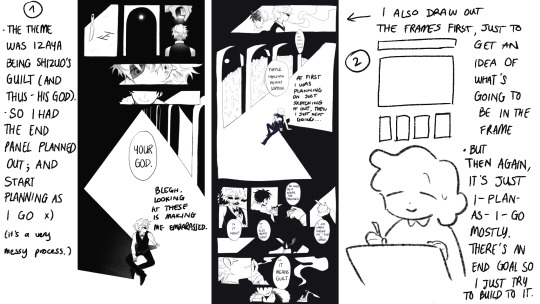
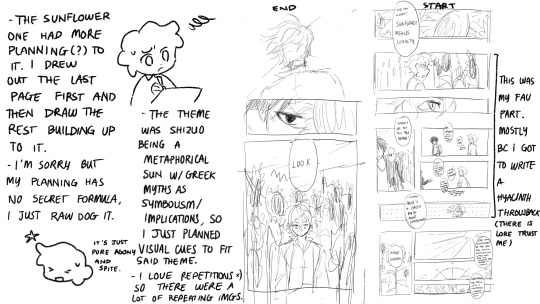
I use Procreate to draw, and I’m not good with technologies so I just use brushpacks and the defaults ^^’

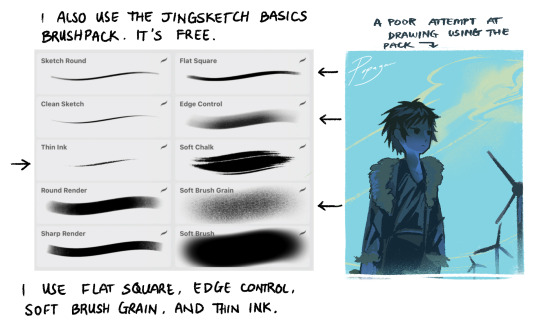
Here’s the link to Jingsketch Basics Brushpack, it’s on Gumroad.
#i kept trying to save this as draft but it kept vanishing#i have no idea where they went#anyway#sorry for the long tangent that just parrots the same point 😭.#i’m excited for asks about my process but my process is just mind-numbingly slow and all over the place#thank you for the ask though I like doing these a lot :)#popask#popaart
12 notes
·
View notes
Text
child superheroes, child soldiers?
taking the child sidekick thing in superhero genre seriously is a lovely thought exercise that can make for some exceptional stories. [please note: i like child superheroes. i love them, in fact. im not saying don’t write stories where child superheroes are socially acceptable, okay, this is just a killjoy thought exercise that i find fun]
at the core of it is the tension between a child’s autonomy over their own life, and adults’ responsibility to do what’s best for children. that is a tension that is very clearly weighted in one direction in our society—adults have near total control over the children in their lives. children are an oppressed class in our society. children are arguably the largest class of oppressed people in our society, in fact. what they want so rarely matters to the adults around them, or to the law or society governing our lives.
it’s easy to take the child superhero/sidekick thing seriously and say “the adults shouldn’t be allowing this. they should stop this” with the underlying thread of, by any means necessary.
what complicates this, if you’re doing it right, is that children are actually human people that deserve the same rights as everyone else, even if they aren’t entitled to them right now in our society.
take a moment and try to remember when you were a child, if you aren’t still a child today. do you remember how much that sucked? It sucked for me, personally. My parents were great parents, but I spent my entire childhood seething with rage because I had no control over everything.
let us turn for a moment to the eternally relevant bill watterson for an illustration of this:
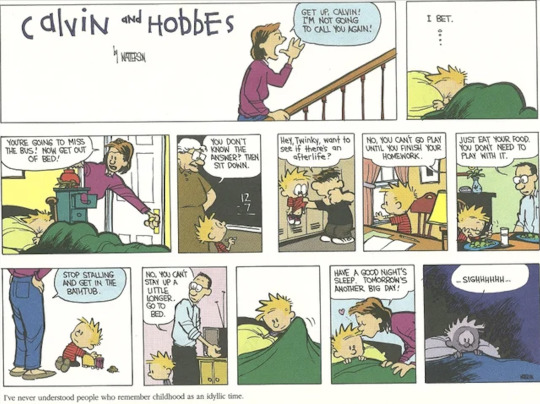
[image description: a calvin and hobbes comic strip. in the first panel, calvin’s mom says “get up, calvin! i’m not going to call you again!”. in the second panel, calvin is still in bed, under the covers, with a thought bubble that says “i bet.” In the third pannel, calvin’s mom is telling him, “you’re going to miss the bus! now get out of bed!” in the fourth panel, calvin is at the chalkboard in his classroom. calvin’s teacher is telling him, “you don’t know the answer? then sit down.” in the fifth panel, a bully is holding calvin up against the lockers and telling him, “hey twinky, want to see if there’s an afterlife?” In the sixth panel, calvin is sitting at a table that has his homework on it; he’s looking out the window; one of his parents is saying, “no, you can’t go play until you finish your homework.” in the seventh panel, calvin’s family is at the dinner table; calvin is looking disgustedly at his food; calvin’s dad is telling him, “just eat your food. you don’t need to play with it.” in the eighth panel, calvin is playing on the floor; his mom is telling him, “stop stalling and get in the bathtub.” in the ninth panel, calvin’s dad is turning off the TV and telling him, “no, you can’t stay up a little longer. go to bed.” in the ninth panel, calvin is getting in the bed. in the tenth panel, calvin’s mom is tucking him in, saying “ have a good night’s sleep. tomorrow’s another big day!” in the eleventh and final panel, calvin is alone in his bed, with a distressed face, sighing heavily. end image description]
Living as a child with adults, for me, was like living under a benevolent dictatorship—sure, they’re great and all, but that doesn’t change the fact that i didn’t vote for them, I didn’t choose this, they didn’t ask for my input, and they can ignore me and do whatever they want with me at any time. the adults could ask what I wanted, and try to follow it, but that’s not a matter of “my rights as a human being,” that’s a matter of personal preference on the part of the adults in question. it’s a facade of rights, a little dance you can do to make the child feel better.
if you were a kid like me, you understood the difference and found it infuriating. having autonomy as an adult, to me, was like....being able to take a full breath for the first time in my life.
at the same time, to circle back to the child superhero question—holy shit, children should not be superheroes. like. that’s a lot of violence; that’s a lot of violence for a kid to commit, that’s a lot of violence for a kid to endure. it’s absolutely 100% bad for them, it’s wrong to endorse it, and it’s wrong to allow it in any way. no one should frankly be put at risk like that, but children especially should not, given the trauma it’ll inflict on their body, mind, and soul.
a great character to explore this with is captain marvel/billy batson, actually, because you can’t stop him. not without seriously injuring him physically or mentally, and even that is incredibly difficult if not impossible for most people to do. he forces you to respect his autonomy as a full human person, something most children cannot do.
another great character to explore this with is jason todd. he died being a child superhero, it fucked him up immeasurably, and he’s pissed as hell about it on multiple levels. at the same time, he is also a human person with rights who deeply, deeply values his autonomy and ability to control his own life.
so. in front of you is a child who is or wants to be a superhero. this is their express wish for themselves, this is how they want to help, how they want to interact with and serve their community; this is what they have training to do or are asking for training to do.
do you let them? do you help them? do you stop them?
#thought exercise#child superheroes#the ethics of child superheroes#children are an oppressed class#superheroes#captain marvel#billy batson#jason todd#robin#red hood#also:#bonus calvin and hobbes
23 notes
·
View notes
Text
doodles (Joaquin Torres x Reader, Soulmate!AU)

PAIRING ››››› Joaquín Torres x GN!Reader
REQUEST ››››› ya know the soulmate au alphabet? Could i request Torres + b and w from the alphabet?
b...ody art (doodles that a person draws on themselves appear on their soulmate’s skin). g...uardian (it is said that the person who saves you from a near-death experience is your soulmate—drowning, car crash, etc.)
WORD COUNT ››››› 1,255
WARNINGS ››››› none
A/N ››››› Sooo I kind of cheated by combining the two letters. Also the writing style is kinda different from my usual story work, but hopefully both risks pan out.

The first picture to ever blossom on his skin is a bird.
The other boys in class have flowers and suns and clouds and little stick figure girls and boys, but he has a bird. And while theirs are sketchy and smudged and disproportionate, his looks as if it's been plucked from a picture book with its steady lines and cartoonish detail.
He'd been surprised to find it, nestled into the crook of his elbow, only appearing when he raised his hand to answer a question. He's so used to seeing his friends with images that littered the backs of their hands and wrists and thighs, he’d never thought to check anywhere else.
A thought crosses his mind.
More than crosses.
It takes over.
He knows he isn't supposed to.
If his teacher catches him, he'll get into trouble. He's not even supposed to have a pen in class. The rule's supposed to help kids avoid the temptation of sending off doodles to their soulmates. Of course, like all school rules, kids find a way around it, keeping pens tucked away in pockets and backpacks and lunch bags.
He's never been one to break the rules, but this feels like he has to. His soulmate's out there somewhere, waiting for him. It only feels right to assure them that he's waiting for them too.
Joaquin pulls the pen he keeps tucked in his desk in hopes of just such an occasion and quietly uncaps it. Carefully and stealthily, he drags the pen tip across his skin, eyes darting up to track the teacher’s movements and make sure he doesn't get caught. As a result, the drawing isn't very good. The head's too big for the body and the feet too long. He’d attempted to draw the wing twice, leaving the lines thicker than the rest of the bird. But it's there, facing the first and chirping out a note, so they know he's alive and thinking of them in this moment. And that had to feel nice.
He sticks the pen back in his desk, looking up at the board and quickly copying down the problems he’s almost missed. It's not until he reaches forward to pass in his paper that he notices the addition to the doodle. Two eighth notes tweet out from the first bird.
He smiles.

It becomes increasingly clear that his soulmate’s an artist.
Most people don’t have doodles on their arms and palms anymore. Instead they have drawings sketched into places only they can see--secret notes passed between soulmates. But his body is littered with art.
Intricate patterns bloom across the back of his hand, and twist and twirl up his arm. His forearm becomes a comic strip. Constant commentary on their day or whatever social issues are on their mind. Sometimes they leave a panel open for him to finish. His drawing hasn’t improved much from the first bird.
He wishes he could send along words of praise or encouragement even though he knows words won’t go through.
He wishes that they would use this gift to pass along messages like just about everyone else his age does. But all attempts at starting a conversation like that have gone unanswered. Instead, he simply gets to witness their art and their life play out across his skin. And Joaquin has learned to be content with that.
Because while other kids are coordinating their futures around their soulmates and tailoring all plans to match the other’s, he gets to make his decisions free. He gets to sign up for the Air Force ROTC without a shred of guilt or pushback like some of the other cadets have to deal with.

Their doodles are what keeps him grounded. Throughout basic and his first deployment, their delicate designs and drawings keep him company in those moments when he feels absolutely alone. They make him feel human in moments where he’s asked to be inhuman.
Their art has saved his life more than once too. The obvious doodles keeping him from doomed missions and distracting him for just long enough to avoid disaster. But more than those obvious, blood running cold, vomiting from how close it was moments, the doodles save his life because they are a constant.
He’s not the only one who appreciates the art either. The others in his unit laugh at the comics his soulmate still draws on his arms. They marvel of the intricacy of his soulmate’s work. On how they’re able to create such a detailed band of wild flowers around their own tricep. They laugh as he attempts to draw a bird amongst the flowers. He wonders if his soulmate knows they’re a bit of a celebrity amongst the 547th.
He wonders if he’ll ever get to tell them.
That’s the thought that weighs heavily on him as he watches his friends on base turn to dust around him. As he watches planes fall from the sky and plummet to the ground. As he watches the gentle waves and roles of the ocean that cascade across his forearm disappear.

It's five years before another doodle appears on his skin. He almost cries when he sees it. A small cartoon bird wipes sweat off of its forehead as if relieved.
He lacks all creativity in terms of response and just surrounds the bird in a cloud of hearts.
And that's their reunion. After this, life continues on, and their established routine continues. While the rest of the world still feels like a mess, the familiar rhythm of waking up to a new comic, of finding a new illustration branded on his shoulder makes him feel whole again.
The art maintains its affects on others as well. Both Sam and Bucky like to tease him for the "garden on his arm" or tell him he's a "human gallery." But he notices the way they practice drawing on their arms, watches as the other eyes the spot it appears on their own skin and mercilessly roasts it. Bucky has asked Joaquin if he's willing to trade soulmates more than once.
Joaquin's not.

Ideally, Joaquin would have met his soulmate under calmer circumstances.
Maybe they could have met at a Starbucks when they accidentally reached for the same drink and noticed the matching patterns on each other's arms.
Maybe they could have met while his soulmate was taking a tour of the base, and he just so happened to stop and say hello to the guide and realized that he had the same three birds on his shoulder.
Maybe they could have just finally coordinated a time to see each other face to face.
Instead, he catches them as they're pushed from a stolen helicopter.
Later, they tell him that they wish he'd just walked into their tattoo shop. That his first impression of them wasn't screaming and crying and just about ready to vomit all over him. That they wouldn't have blamed him for keeping the connection a secret when the first thing they said to him after saving their life was "Ow! I think you broke my back." (Which, for the record, he didn't. It was just bruised.)
But when he sees the band of flowers encircling their tricep, he can't keep it in. He can't believe he's holding his soulmate in his arms. The person who's kept him company for almost two decades.
So he says something almost as idiotic as they do: "You're the bird."
And that pretty much solidifies the fact that they're meant to be.
#joaquín torres x reader#joaquín torres#joaquin torres x reader#marvel#joaquín torres x gn!reader#joaquin torres x gn!reader#gender neutral reader#genderneutral!reader#gn!reader#fatws fic#soulmates au#soulmate!au#marvel fic#mcu fic#joaquin torres fic#joaquín torres fic#joaquín torres imagine#torres x reader#torres x gn!reader#torres x you#joaquín torres x you#joaquin torres x y/n
324 notes
·
View notes
Note
Hey there---I have been hunting for your blog forever! A classmate of mine brought thumbnails of your work to a drawing session, and we have been obsessing over your people. I find the way you illustrate long noses and sort of androgynous-looking faces and big hands really refreshing, and your werewolf druid Vaara is super charming! They really make me want to know more about your campaign world.
I hope you don't mind sharing, but I was curious what software(s) you used for the comic you made, A Dream with Rain. Do you have any general tips for people trying to draw better? Sorry for bamboozling you with questions. Delighted again to have found your blog!
OOof thank you! ❤❤❤ This was a delightful message to get! So cool to know my art exists outside my own little circle (it's sometimes difficult to realize that there are actually so many people behind all the notes my art gets). And also an encouraging ask because I've been struggling with my art style a bit lately (feeling like finally slowly getting there and out of art block now tho). But one of my goals has been to use bolder shapes and lines (like larger features and other than snub noses), glad that you like them as well! And if you read my tags I do have many non-binary characters & I like to play around with masculine and feminine features anyway so ough it's cool that it shows through the art as well ❤ (And oh check out my sis/sibling's art blog @artist-rat as well, they also have a very funky style and draw so expressive faces!!)
This is getting long, so here's a quick doodle of Vaara for you and rest of the answers under the cut!
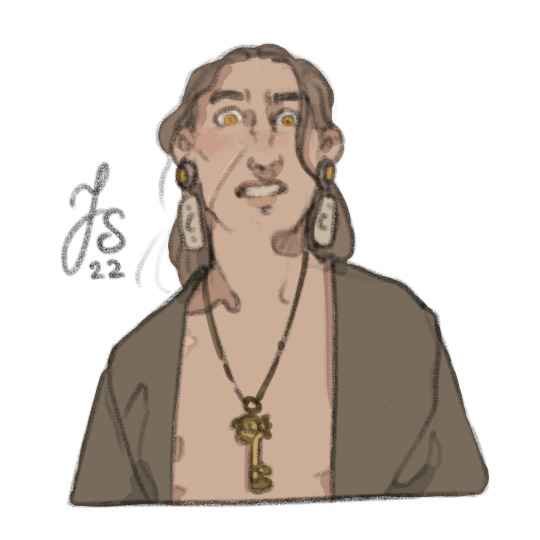
The campaign Vaara is in is still in the beginning, so I don't know yet either what's to come! My friend @iijadraws (who is the DM) knows more about the lore if you want to know (and if she will spill). So far Vaara's archdruid Aalis noticed something bad was happening to their forest in the north and south. Vaara's dear friend Kiilo gave Vaara a precious key/amulet for luck and went north, Vaara gave Kiilo their stone knife for protection and went south. After a day's travel, she found forest stripped of life, and an old empty stone hut/house. Then strange things started happening, like giant unrecognizable beast coming out of the forest and Vaara's own empty eyed doppelganger staring at them from the empty forest. Vaara freaked out, hid into the stone hut, was cornered, and used her now faintly glowing key to open a door within it. The door became portal, and led them to a mysterious house where they are now stranded with Knell (artist-rat's character). Vaara is still mostly freaking out and attempting to run back home (not happening).
Mmm I want to illustrate more scenes and ramble more about both of the DnDs I'm currently playing (Rhiam's and Vaara's). I have one Rhiam background info & illustration coming up and will hopefully get it posted tomorrow, and I'd like to do more of those for both of them!
THEN What software I used: I've been using Krita for years now and I really like it! It's free and constantly developing (there have been a couple of hiccups in the past, but I haven't had any issues with the latest versions). If you want to know more about some specific feature I used (like brushes, effects, settings in general) feel free to send me another ask/message!
And general art tips: "Practice" is kind of a old and empty answer, so, here's some bit more specific stuff I learned from my art teachers (keep in mind that my art education isn't university level, but I went to a really great upper secondary school (high school?) that had special emphasis on visual arts so it's something).
Try to avoid using eraser or blurring. Especially the latter. One of the first lessons our class learned was not to blur pencil lines with our fingers/paper when shading our works. It was forbidden and it caused outrage, but was really helpful in the end. Airbrush tools have their place, but learn to shade and mix colours without it first (add or lessen pressure, select in-between color manually, cross-hatching). Personally I’ve been really digging using really sharp edged brush to colour my works lately (for paintings I use softer tools, but sharp coloring works really well with my softer line art I think!)
Studies are a great way to improve whether it’s anatomy or colours. I had weekly classes with model for a couple of months back in school but now I’m mostly using images from Unsplash (they are free to use) for color and painting practice. If you want to improve fast, try to do many sketches as fast as you can: we started with 3 minute sketch and then lessened the time so that in the end we were doing 10 second sketches of the model. I think there are sites specifically for this purpose where images/models change with timer? Here big paper & pen/brush might also help (no time to dwell in details, get the overall shape).
Try different mediums and methods: before my art school, I mostly drew with a pencil on A4 or smaller paper, and my art was kind of faint, careful, full of little details, stiff. Then in school I was forced to use watercolours, and acrylic and oil paints, try digital art, use big canvases, sclupt things out of clay and whatnot. It gave me a better sense of how shapes and colours work, but also helped me get bolder with my art (that is still a process, but I developed a LOT). I had drawn my entire life before that but I was shy to change my art and methods. And I know materials can be expensive, but work with what you have. My teacher once made a still life composition out of cleaning cart and other random stuff and made us draw it on a really big paper with big chunky chalks that were taped on long sturdy sticks found from forest. Relatively cheap but forced to draw big shapes and use your entire body rather than just wrist. It looked kinda like this and it’s still one of my favourite classes:
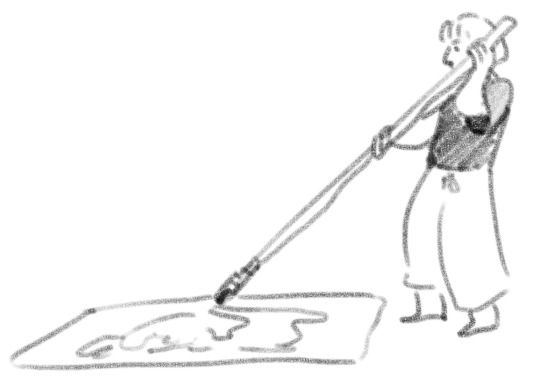
Again, feel free to send ask about specific art (or other) things you'd like to know if any come to mind! And thanks again for the message! Have a great day/evening/whatever time you have there!
#hope you don't mind this took a bit time and got a bit longer :D#i tend to ramble when i write#ask#livereats#Vaara#and other stuff#hopefully not too many typos#and when I say my art USED to be full of details I mean there was A LOT of them and they were UNNECESSARILY polished
33 notes
·
View notes
Text
The reasons to ban Maus are some of the stupidest reasons I’ve ever seen, and that’s saying a lot cause I’ve seen the reasons for a number of banned books.
In 2018, I was in my last semester of college, for the history department in order to get your degree, you had to write up a final paper that was massive, fifteen pages minimum, on whatever topic the teacher assigned gave you.
My teacher wanted us to write a paper based on an biography/autobiography that spoke of someone living through a war. Could be a soldier, could be someone on the home front, as long as it was a biography of a real person, and it had to be from a book.
I already had another massive paper I had to write that semester for a different class, so I asked if I could do my paper on Maus, which was both a biography and an autobiography. My teacher, who is just the most awesome old man, said sure, he’s never had a comic used for a paper before, this could be interesting!
I read this book a few years before on my own, then about two or three years before this assignment for a different history class, so I had a full copy of this book ready to go.
My paper was about the relation between the author, his father, and what effects the war and the culture that blossomed from it had on both of them. Art was born after the war, a boomer, who grew up through eras of change and radical ideas from all fronts, who got into the underground comix world and wrote about the world around him, about his life. There is a whole section in the book, in a completely different style, about Art’s mother and how her death really affected both him and his father.
This comic and the whole comic Maus itself is very bleak, very dark, and based on the truth. These are events that happened, told by the father to the son, who wrote and illustrated what he was told for the world to see what that period of history had done to people like his father and mother. It is not sugar coated at all, we see starvation, abuse, death, betrayal, the horrors of war, hell, even the humiliation of being stripped naked in front of others, all through the eyes of mice under the thumb of oppressive cats and pigs.
Them being animals doesn’t soften the blow, it makes it more unsettling because it gives us a better idea of where they sit on the steps of power, in a sense.
I spent months researching this story, Art’s history, and even the history of underground comix (comics that were mainly written to express ideas and beliefs, not just sex and drugs), just to come out of the project knowing more about the horrors of war for those not on the battlefront.
To ban this book is just to cover up the truth of history. As someone who has spent over twenty years of his life studying history and learning that events have blood splattered on them, it seems like a stupid move to try and keep children from learning this. Wanna know how I learned about the horrors of war as a child?
From the Molly series for American Girl.
There is a whole book that speaks about Molly’s world during 1944, during WWII. There are pages devoted to the tragedy of war. I learned of the Holocaust and the bombings on Japan from a children’s book that did not hide the fact that people died horrible deaths.
And just pages before, I was learning about the home front and victory gardens, then I’m suddenly learning about parents trying to deport their children to England and America to keep them alive, and how Jewish citizens were forced to wear yellow stars.
This comic is much darker than this book, but neither shy away from the truth. To keep banning books about history, history that isn’t even a hundred years old yet, is fucking stupid.
I lived in Europe during my childhood, I saw concentration camps, with no censorship, you learned of the horrors and ungodly things that happened behind those gates. No one told you lies.
America’s need to censor things because the far-right feels that learning the truth is having them lose their grasp on the masses is driving me fucking nuts.
We live in a very smart age, but it’s overshadowed by the absolute stupidity of people who want to ignore things so easily, even though it’s impossible to ignore.
If I had actually went through and gotten a teaching degree, I’d still teach this book, I’d still teach the truth. I don’t care what the fuck I’m told is not allowed, why should I be a coward and lie about things that happened?
God, just... dark themes, nudity, fuckin’ Christian guilt???
Bite me, your reasons are weak.
Sorry, this has been building up for a few days now, and I needed to vent on my personal blog. I didn’t write over twenty pages for a paper in order to graduate to just let this go without a word.
3 notes
·
View notes
Photo
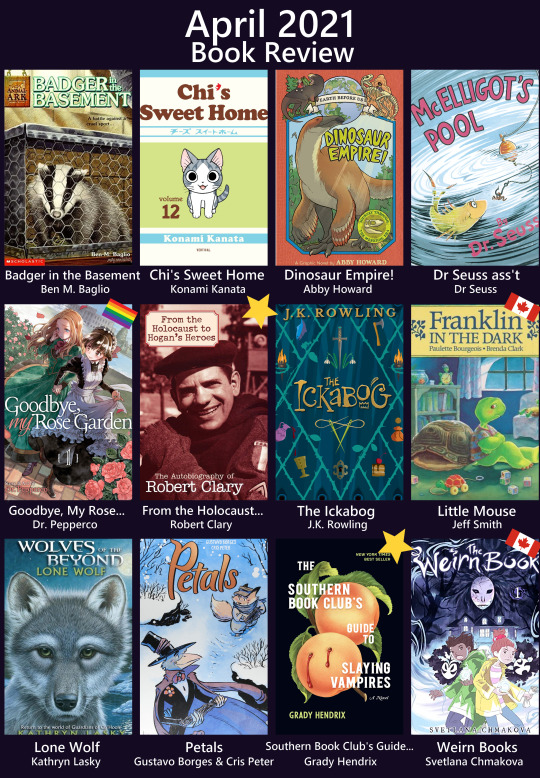
April l was apparently the month for me to revisit some children’s authors who are steeped in controversy at the moment. So here’s my hot (well, lukewarm) takes on issues that absolutely do not need a single other person talking about them. Also some actual good books that I read this month!
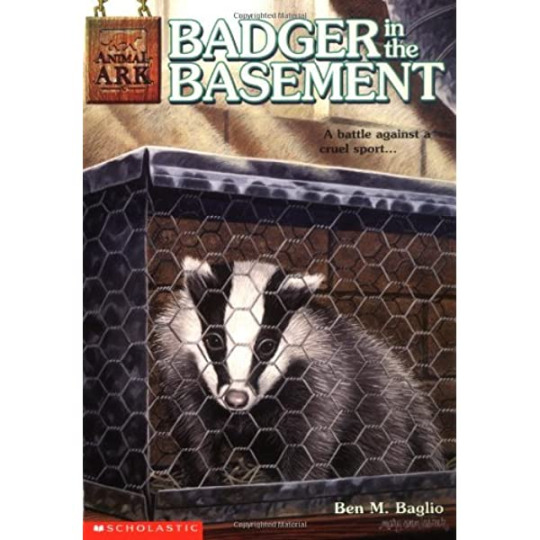
Badger in the Basement
The Animal Ark books are a childhood classic — though I recently found out that apparently there’s a difference between American and British publications, and the American versions didn’t include a lot of actual COOL animals which is… bizarre. As a Canadian stuck in the middle of this, this nonsense drives me nuts. This one was about the main character, the daughter of pair of vets, trying to protect a local badger sett from men wanting to participate in badger digging and baiting. These books are always feel-good, and it was a nice single-day-read while I waited for a library book to come in.
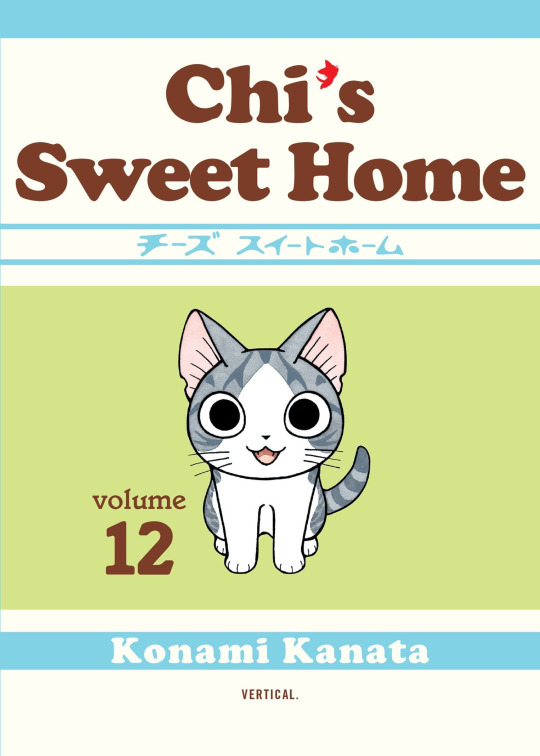
Chi’s Sweet Home
The cutest manga series about the misadventures of a little kitten, Chi, who has been adopted by a loving family. I’ve never bothered to read them in order, but apparently this time I stumbled across the last in the series -- whoops! Still, stood on it’s own pretty easily, and it was a fun read! Things get tense when the family realize that they may have found Chi’s original home… and may have to give up Chi forever.
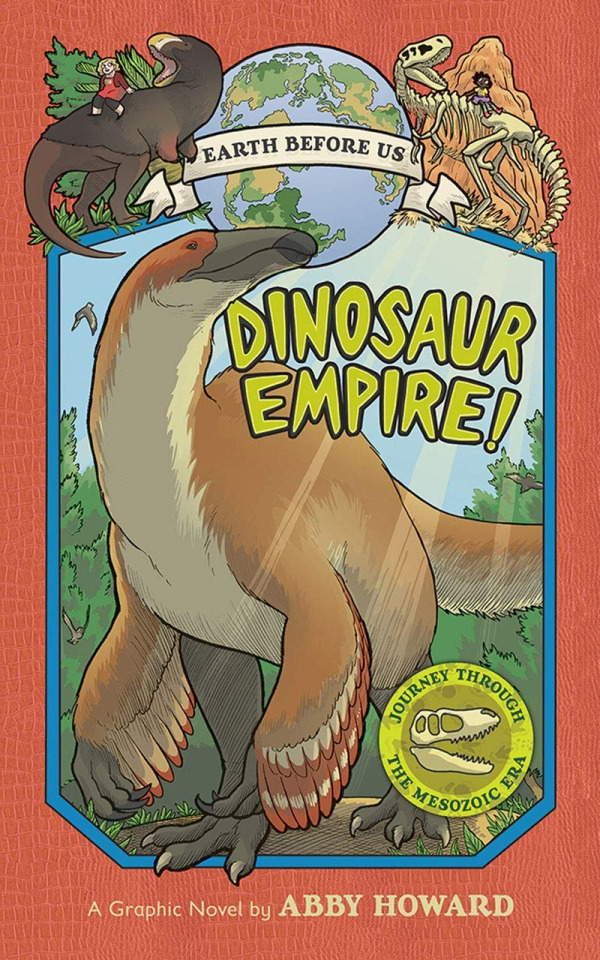
Earth Before Us: Dinosaur Empire!
This was an odd graphic novel, I feel like I’m not sure who the target audience was exactly. It was a nonfiction comic done in a Magic School Bus style, with the purpose of teaching current, up-to-date facts about the animals that lived in the Mesozoic Era. If you’re into dinosaurs, you’ll probably enjoy this! The art is absolutely adorable, I love the dinosaur illustrations, and I learnt some really neat facts. That being said, the pages are really dense, and there’s a lot of info crammed in… some of it will probably go way over a child’s head without specific additional teaching or a very strong personal interest. But that being said, a dinosaur obsessed kid is still probably going to really dig this… as would a dinosaur obsessed adult. It wasn’t my cup of tea exactly but I’m sure it is someone’s.
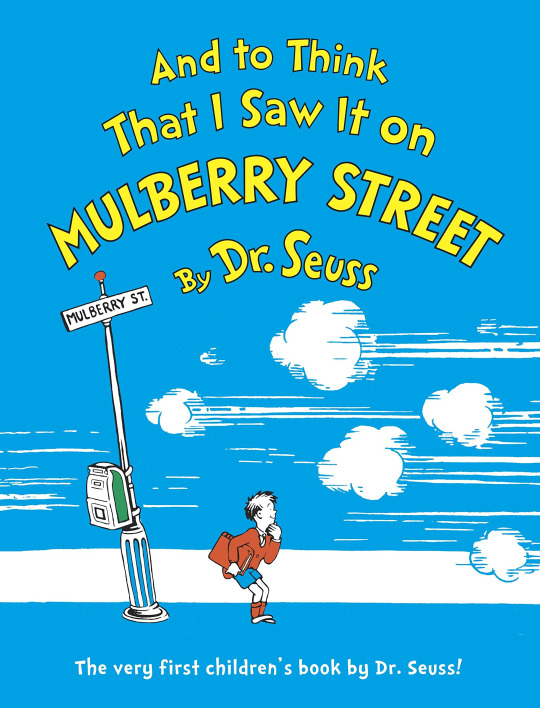
assorted Dr Seuss Books
I love these types of controversies because it means getting to listen to every moron who has never had an opinion on Dr Seuss ever start generating a mile of them out of the aether. So many people are so mad about the six books that are getting retired and I bet most of them haven’t even read them. These are not the friggin Cat In The Hat or The Lorax or even the likes of Yertle The Turtle. I was raised by a grade one teacher, was a voracious reader who loved Dr Seuss, and wrote my university thesis on children’s literature, and I still only knew two of the six books on that list. So by all means, if you want to write an essay explaining why those specific books are worth clinging to, feel free, but if you haven’t even heard of them maybe it’s not a big deal. *grumble*
Anyway, my grousing aside, it gave me the urge to reread a bunch of Seuss books, including the two retiring books I personally knew: McElligot’s Pool and To Think That I Saw It On Mulberry Street. I do still enjoy both, especially McElligot’s Pool which always sparked my imagination, but it’s obvious why they’re being retired and I personally think it’s the right choice. There’s so much good kidlit out there, we can survive without these.
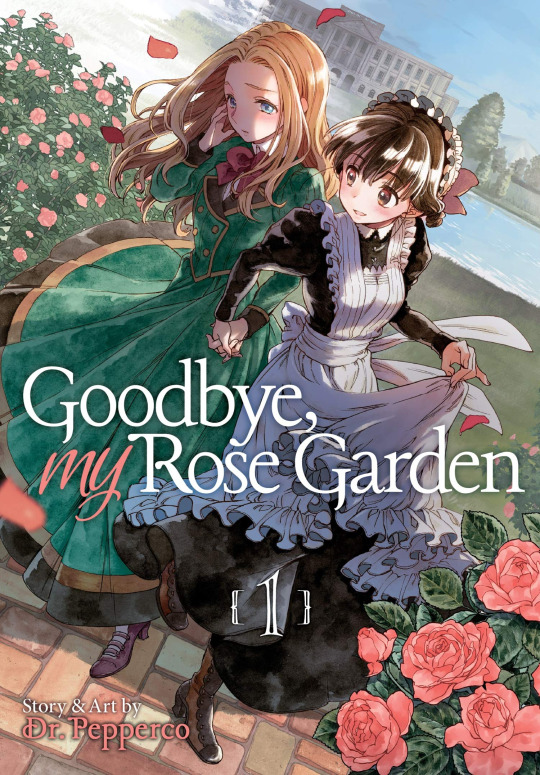
Goodbye, My Rose Garden
A f/f romance manga, fairly standard fair though cute if you’re looking for some historical angst, pretty dresses, and mutual pining. A young Japanese woman moves to England in the hopes of meeting a writer (Mr Frank) who she has long admired. Along the way she is employed by an enigmatic woman with plenty of money, rumours, and melancholy following her. I’ll be honest, uncut romance isn’t really my genre, but I’ll probably still try to the second book to see if the story picks up.
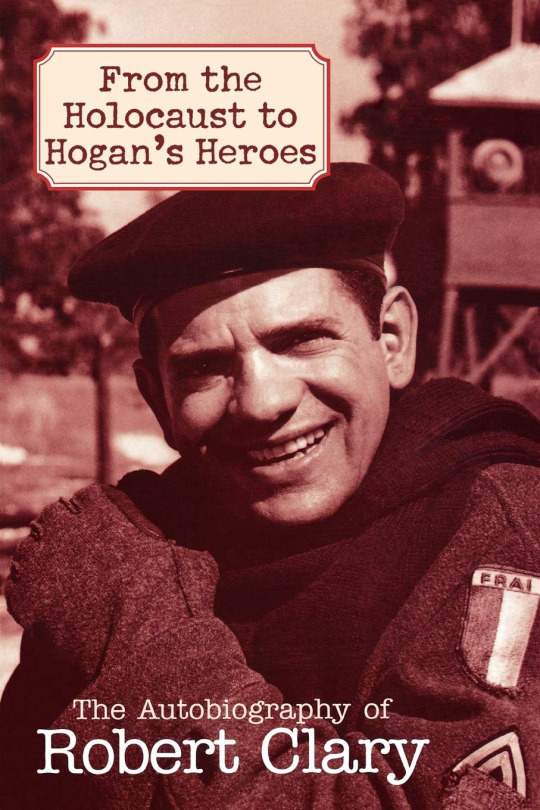
From The Holocaust to Hogan’s Heroes: The Autobiography of Robert Clary
It’s no secret that I’ve been on a Hogan’s Heroes kick. This is the autobiography of Roberty Clary, who plays my favourite character in the show, Louis Lebeau. And holy shit what a life this man has had. He was a Jew growing up in France before the start of the war, and who was one of many children taken away from his family and sent off to the concentration camps in Germany. This was an amazing, intense, inspiring, and heartbreaking read… it has Clary’s voice all over it, and it tells everything from the charming childhood he had, to the horrors of the concentration camps, the brutality of survival, and then about his exciting journey into the entertainment industry afterwards. It’s an experience, would recommend if you’re a fan of the show.
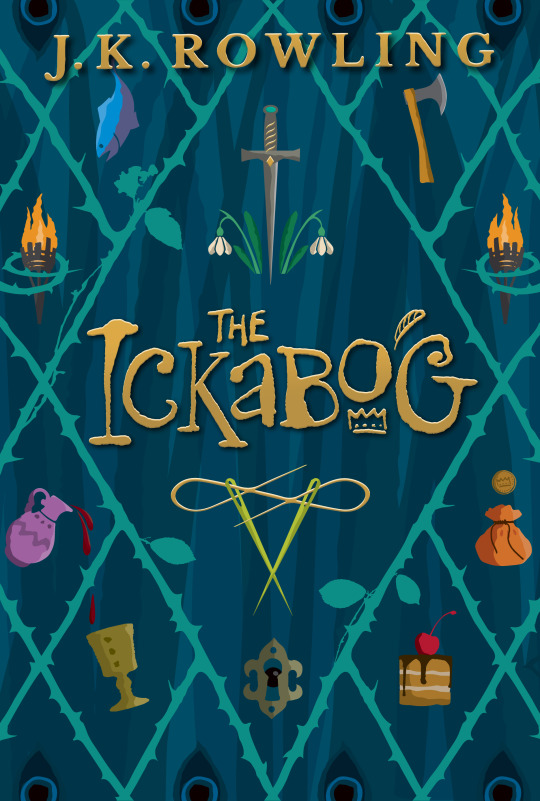
The Ickabog
The second controversial author I read this month. Originally I was going to give Rowling’s new book a miss, given everything that’s been going on over the past few years, but in the end my curiosity got the better of me. Politics aside, it was a fun read! Not groundbreaking, but enjoyable enough and written in an interesting style. It didn’t read the same as a lot of modern kidlit, it felt more like a cross between a classic fairytale and a Dahl book. Perhaps a bit like Despereaux. It tells the tale of how an idyllic country gradually falls into ruin through the ignorance, inaction, and greed, and how a supposedly fictional monster hides the very real, human monsters at the heart of the country. It was cute and pleasant and I’m glad I decided to get it from the library, though for anyone who is choosing not to engage for political reasons: you aren’t missing anything major.
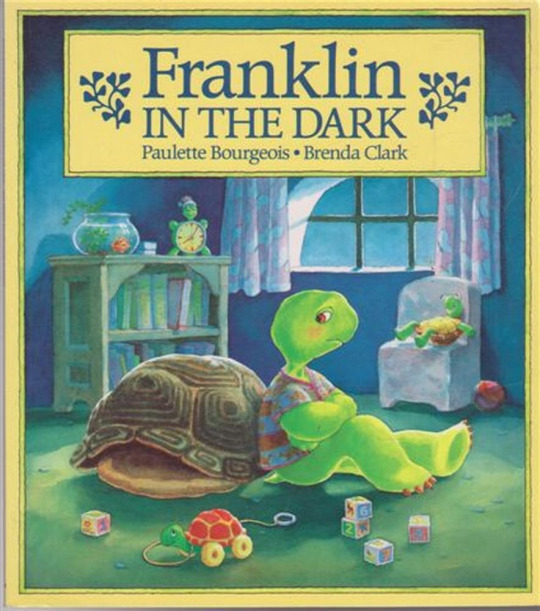
Franklin In The Dark
A Canadian classic. I don’t think there’s a single person my age who hasn’t read or been read a pile of these books, and the nostalgia is so comforting. I found this on Youtube and listened to someone read it to me, and honestly 10/10 would recommend for a calm evening.
The big reason I decided to seek this one out though, was because I finally got to the M*A*S*H episode that inspired this entire series! In the episode C*A*V*E, in which Hawkeye is freaking out over his claustrophia while the camp is forced to take shelter in a nearby cave during some intense shelling, he mentions that if he had been born a turtle he would have been afraid of his own shell, and that the other turtles would make fun of him cause he’d be forced to walk around in his underwear. And so this first story about a young turtle who’s afraid to sleep in his own shell and drags it around behind him. So if you were ever curious, Franklin the Turtle is in fact named after Dr Benjamin Franklin Pierce. (this is also why the French version is named Benjamin!)
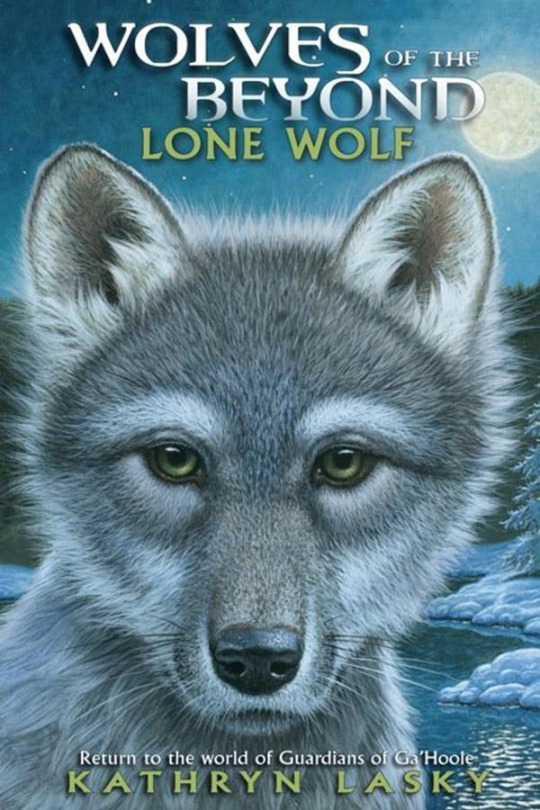
Wolves of the Beyond: Lone Wolf
I loved the Guardians of Ga’Hoole books as a kid but I never read the Wolves of the Beyond series. This first book was an interesting read, Lasky does a great job creating worlds and societies for the animals that inhabit them. Lone Wolf is about a deformed wolf cub who was abandoned in the wilderness to die. And he would have, if a desperate mother bear, who had recently had her only cub killed, hadn’t stumbled across him and saved him, vowing to raise him as her own...
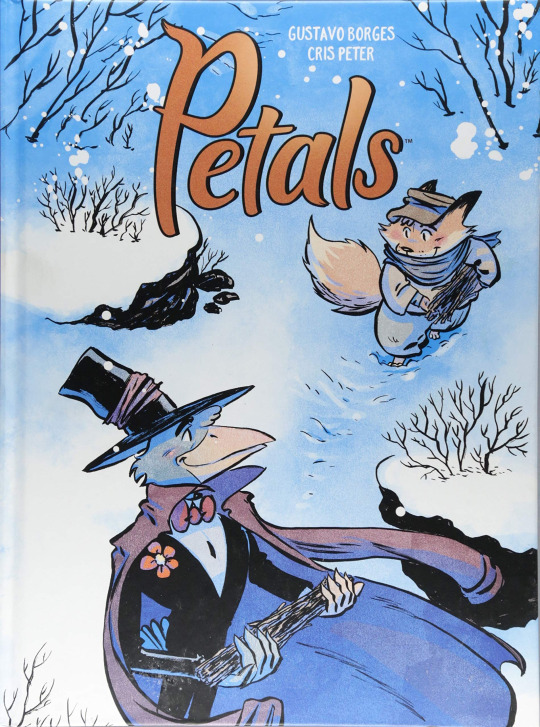
Petals
A “silent” graphic novel. It has beautiful artwork and is told entirely through pictures, no text at all. It’s loves and heart-wrenching, though it left me feeling somewhat unsatisfied… I felt like there should have been more. Still, a neat story.
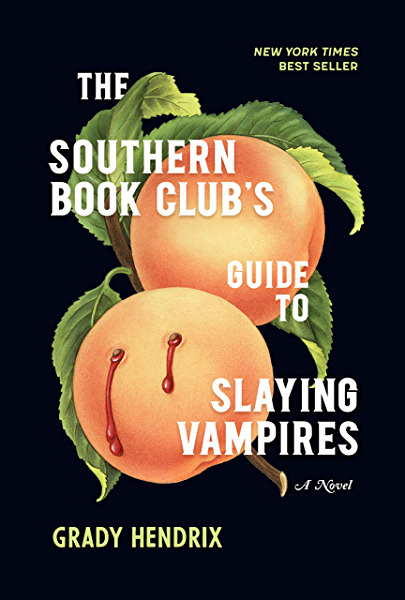
The Southern Book Club‘s Guide To Slaying Vampires
What a banger of a novel!! I can’t recommend this one enough. It’s about a group of suburban mothers in the ‘80s who form a book club out of a shared need for community and a love of grisly true crime novels. But when a strange drifter appears in town and starts setting down roots… and when children begin disappearing… these women need to band together to confront the horrors that have invaded their neighbourhood, and face down not only a terrifying monster among them but the patriarchal system that allows it to flourish. To quote the preface:
“Because vampires are the original serial killers, stripped of everything that makes us human — they have no friends, no family, no roots, no children. All they have is hunger. They eat and eat but they’re never full. With this book, I wanted to pit a man freed from all responsibilities but his appetites against women whose lives are shaped by their endless responsibilities. I wanted to pit Dracula against my mom. As you’ll see, it’s not a fair fight.“
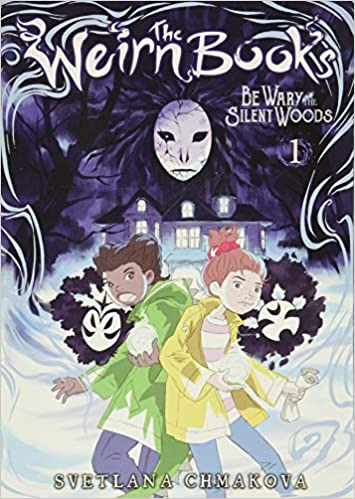
The Weirn Books: Be Wary of the Silent Woods
I love Chmakova’s graphic novels, though I’ve only ever read her slice-of-life middle grade series before. This one is pure fantasy and very fun. It’s about two cousin “weirns” — witches with demon familiars — who attend the local night school. Things get strange though when an ominous figure appears outside the old, abandoned school house deep in the Silent Woods, and begins tempting children down its path…
I’m very much looking forward to word of a second book and was honestly kind of surprised that I haven’t heard more about this book given how popular her other series is. This has all the same charm and quirks but for those of us who prefer stories based in fantasy rather than reality.
And A Bonus...
For some masochistic reason I got a Garfield book out of the library. Jeez, if I didn’t love these as a kid, I found them absolutely laugh out loud hilarious, and now I just don’t see it anymore. But here I will share the one strip in the book that actually made me laugh

#book review#book reviews#chatter#dr seuss#hogan's heroes#robert clary#the southern book club's guide to slaying vampires#animal ark#dinosaur empire#the weirn books#svetlana chmakova#canadian literature#canlit#kidlit#children's literature#wolves of the beyond#mash#franklin the turtle#chi's sweet home#manga#goodbye my rose garden#kathryn lasky#the ickabog#jk rowling
40 notes
·
View notes
Note
I recently read Balancing Toy and Cross Game because of you and I loved both! They were so good at depicting mundane life and packing emotion in subtle ways. Could you recommend some slice of life manga?
this makes me so happy, omg! 😭 i’m really glad you enjoyed them, i love the slice of life genre so much for how it’s used as a medium. i’m going to recommend some other titles here, but i think yamakawa aiji and mitsuru adachi’s other works are definitely worth checking out as well!
sangatsu no lion (manga/anime) - this may be one of the more obvious recent choices within the genre, but i think it’s with very good reason! chica umino has the slice of life genre down to a science. the story primarily follows rei, a shogi prodigy who has recently started to live alone due to tensions he felt he was creating within his adoptive family. he’s very lonely and depressed due to what he felt was an invasive experience on his own part, so a lot of the narrative follows him being reached out to by other people and him learning to ask for help rather than keeping all of his struggles to himself. there’s a lot of complex emotions and trauma tied into the narrative, but they’re often depicted against very simple situational backdrops, so it feels like you’re walking through ordinary people’s lives but in a way that’s deeply relatable. i believe the anime is on netflix so that’s very convenient as well, and i think it does a beautiful job of conveying a lot of the imagery that’s so crucial to depicting the ideas contained within the story. i would definitely recommend chica umino’s other primary work, honey and clover, for similar reasons as well, but i recommended that in my shoujo recs post already so i won’t rehash that here
azumanga daioh (anime/manga) - i’m not sure how to describe this series. it follows a group of teenage girls (and a few of their teachers) as they navigate three years of high school. and that would sound like an at least semi-serious endeavor, except it isn’t really on the surface. the series operates as a progression of chronological one shots centered on different gags and nonsensical situations, and it makes for comedy that i think has remained pretty timeless despite the series being nearly two decades old. the anime is great, both the sub and dub are phenomenal, and the manga is written in the form of those comic strips you used to read as a kid on sundays. it’s just super simple, lightheartedly funny, and surprisingly heartfelt when it wants to be due to the relationships you see illustrated between the girls. i would recommend kiyohiko azuma’s other primary work, yostuba&!, for similarly lighthearted and funny material. also, these are some of my favorite scenes from the anime
ojamajo doremi (anime) - this falls more into the shoujo category, esp since the mcs are witches who navigate a witching world, but i think it operates by slice of life parameters because of the way the story is told. ojamajo has received a lot of praise for its timelessness due to the relatability of its multiple scenarios to people of all ages and backgrounds. most simply put, it starts as a show about a girl who accidentally becomes contracted to a witch and so becomes a witch-in-training herself. doremi gets into all sorts of ridiculous messes and has to solve them not just through use of her powers but also just per normal problem solving skills. there’s narratives about friendships, relationships with our family and our teachers, growing up, learning to accept different kinds of people, etc. and similarly to azumanga, tho it initially feels like a purely one shot set-up, the plot and development of the characters builds in a way that’s subtle but also pleasingly noticeable. it’s just super down to earth and kind and funny, and there’s even a movie that came out last year (i believe?) to celebrate the twentieth anniversary, which made its main characters be girls who had grown up watching ojamajo and were now seeking out their own adventures as they grew up. i think that’s really sweet
horimiya (manga/anime) - this is perfect to get into right now bc the anime just started airing! it follows a pair of students, hori and miyamura, who come to find out about each other living “double lives”. hori hides the fact that she goes home everyday to take care of her house and her brother bc her parents are always at work, and miyamura looks like an otaku bc of the way he dresses but is actually just a normal guy with some tattoos and piercings. they coincidentally cross paths one day and are made privy to each other’s “secret” lifestyles, so a friendship and eventually a romantic relationship strikes up between them. the nice thing about the manga is that not a lot of time is spent on getting them into the relationship. you actually see them as a couple for most of it, doing couple-y things, engaging in couple-y conversation, having couple-y squabbles. there’s also a cast of characters outside of these two who deal with their own day-to-day issues and such, so overall it’s a nice casual read about people and how they interact. i wouldn’t say it ever gets angsty (at least not that i’ve read so far) but it’s nonetheless very enjoyable for its straightforwardness and simplicity
bokura ga ita (manga/anime) - i haven’t watched this in a long time so my memories are somewhat hazy, but i think this features one of my favorite explorations of grief in a shoujo manga. it starts with nanami, a high school freshman who hopes to make new friends but is also put-off by the most popular boy in school, yano, bc of his superficial attitude. yano is actually still emotionally recovering from the death of his girlfriend the year prior. she died in a car accident and was with her ex-boyfriend at the time, so yano assumed she was cheating on him, and instead of properly processing the event, he pretends to act like he doesn’t care. he and nanami grow close over the course of the narrative, but there are a lot of levels to yano’s trauma and grief that keep them apart in various ways. it’s very much true to that era of romance manga in the sense of all of the ridiculous drama and love lines, but i think it’s really weighted because so much of that drama stems from real trauma and characters’ issues with depression, etc. if you loved nana or paradise kiss, i think you would enjoy it. also, if memory serves, i believe the anime covers only half of the story, prior to a major time skip
i didn’t want to feature any repeats, so i’m going to direct you to my shounen recs post for some more stuff i love from the slice of life genre as well. in particular, i think silver spoon and sket dance are great for that (as is oofuri, but it’s also a sports series very detailed with its sports lore, so idk if you’d be interested in that). and while i haven’t read the following personally, these are some trusted recs that i’ve either been meaning to read or got from friends: mushishi, oyasumi punpun, barakamon, nichijou, beck. i hope this all helps!
#sangatsu no lion#azumanga daioh#ojamajo doremi#horimiya#bokura ga ita#slice of life is fun bc it overlaps with a lot of genres#so you can consume a really broad range of content#i think (hope) that the specific recs i gave all have different appeals so i hope you end up enjoying any one of them!#mine:recs
17 notes
·
View notes
Text
Year 1 Week 1
year 1
week 1
day 1
identity and position 5th october
let the tutors know if there are any problems
independent work and collaborative work
learning on studios
developing self directed practise and presentation skills
manage your time 7th december is the deadline meet the deadlines make sure your meet the deadline you have opportunities to succeed take pictures of everything and record the work and the processes of the ideas and work to be professionals know what your work is about
day 2
day 2 (online class) 1000-1245
so we were asked 3 questions:
1. is illustration? A form of art communicating a message or showing a visual idea , recording a plant/ form of life in the wild recording an event unfolding before you (I remember seeing a painting on my trip to Russia of a massacre bloody Sunday) in fact in one could say Communist Russia and Germany when run by Adolf Hitler used art and radio to push their ideology and communicate a positive facade of their horrid plans for their respective countries.Especially illustration in newspapers which at the time people were an important part in human life especially in Europe.Your everyday reliant on newspapers to tell them the truth new shops to check out new restaurants to visit new products and services to buy,2. what is its purpose?- One's expression to bring joy or to just feel and create sometimes there is no reason you just felt like making something - to model or demonstrate a service ( a digital animated character walking) a potential product (iPhone 11pro), building,space,enviroment,scene,character etc.- to communicate ideas,views,opinions,thoughts,irony e.g political cartoons in british newspapers or films - to entertain / divert the masses - film/comic strips in newspapers or online,books,animation,games etc.- to make people think - painting or film or anything Banksy does his instagram is awesome 3. what can illustration do?anything literally it can impact all industries: helping pharmaceuticals and chemists on how to perform an experiment or how the lab should look the possibilities are endless- restaurant menus- visual ideas - storyboards for tv and films et design etc.- product design cars electric devices- where the fire exit signs- online training videos for companies animation for scenarios how to videos - a brand logo apple,The Walt Disney Company, the vue cinema logo etc.From wikipedia - ' Contemporary illustration uses a wide range of styles and techniques, including drawing, painting, printmaking, collage, montage, digital design, multimedia, 3D modelling. Depending on the purpose, illustration may be expressive, stylised, realistic or highly technical.Specialist areas include: Architectural illustration Archaeological illustration Botanical illustration Concept art Fashion illustration Information graphics Technical illustration Medical illustration Narrative illustration Picture books Scientific illustration' here are the groups i was in zoom group 5 answers :an interesting find i find whilst researching :/An illustration is a decoration, interpretation or visual explanation of a text, concept or process,[1] designed for integration in published media, such as posters, flyers, magazines, books, teaching materials, animations, video games and films. An illustration is typically created by an illustrator. Illustration also means providing an example; either in writing or in picture form.The origin of the word “illustration” is late Middle English (in the sense ‘illumination; spiritual or intellectual enlightenment’): via Old French from Latin illustratio (n-), from the verb illustrare' research sites:https://en.wikipedia.org/wiki/Illustration#:~:text=An%20illustration%20is%20a%20decoration,typically%20created%20by%20an%20illustrator. https://www.wordsense.eu/illustrare/ for me illustration is my expression whether via biro pen or watercolours etc. whatever medium this discipline can bring joy it can evoke an emotive memory it can inspire civilians to go to war and 'fight the huns' which many cartoons in newspapers did it during the first world war and second world wars.evoking a sense of comradery a call for heroes a call to 'do your bit' 'keep calm and carry on' and 'do your bit for the war effort'. illustration has the power to communicate an idea or various ideas therefore it has the ability to influence people and inspire and positive or negative reaction illustration and therefore art has power ...where do we get our info or inspo from?the internet - images,text,youtubecinema - filmstv- adverts games - ubisoft's assassin's creed 2,brotherhood what are you inspired by in accordance to the senses?Sensory integration is the process by which we receive information through our senses, organize this information, and use it to participate in everyday activities.An example of sensory integration is: Baby smelling food as they bring it to their mouth Tasting the food Feeling the texture Determining what this food is and if they want more https://pathways.org/topics-of-development/sensory/You read that right! Most people think there are just 5 sense, but there are actually 7! So what are the 7 senses?How might we use these senses in art Sight (Vision) - light the effect of light,everything we see nature social media,traditional media fine art in newspapers, film,photography,books,cartoon,animals,water,rocks,buildings and products,food, clothes,people etc.
Hearing (Auditory) - hearing a problem and trying to figure out how to fix it,hearing sound and figuring how to visualize it or incorporate it
Smell (Olfactory) - thinking of a memory how one felt at a specific time and trying to encapsulate that feeling that emotions and expressing that emotion or how one feels before during and after a smell e.g the air during a hot salty windy day at bournemouth beach
Taste (Gustatory) - memories,good food the feeling of gooey melting chocolate in my mouth trés delicieux!
Demonstrate that in a physical tangible state and or image whether it be traditional analogue on paper perhaps a 3D digital
Touch (Tactile) - textures and grains and movements of a rock of thing feathers and feeling and recreating that or recording it perhaps Vestibular (Movement) - the movement and balance sense, which gives us information about where our head and body are in space. Helps us stay upright when we sit, stand, and walk. - Dance the feeling of a wave hitting the rocks or water against you
Proprioception (Body Position): the body awareness sense, which tells us where our body parts are relative to each other. It also gives us information about how much force to use, allowing us to do something like crack an egg while not crushing the egg in our hands. - inspire to create an animation or a short film of various movements and how the character walks runs etc. various body movement prior to filming character development *FILM/TV/THEATRE mechanical horse like in war horse etc.
* Emotion and feeling - making people feel a different emotion or various emotions feeling empathy or anger making people feel inspired to better society
skills that I am confident in : paying Attention to detail
- Interpersonal and Communication Skills - Teamwork and Multi-tasking - Adobe Photoshop, Illustrator, Lightroom, InDesign, After Effects, Premier Pro and Capture One 10- Drawing- Painting- Illustration- Calligraphy- film and digital Photography as well as editing I care about and hope for :
Our World:- Education for everyone - ignorance is not bliss but a trap to be manipulated and controlled.Critical thinking discussions and emotional and mental growth is a positive thing is is an asset to society.Every human being able to have a full education for them and their needs if they are great at art and history they should not be shamed for not doing good in science!The current Prussian educational system is not helping everyone excel in the subjects they are good at - it was meant for military education in the ancient world after all however we need an improvement.Especially on the teachers hired and trained.Some countries are allegedly failing students just so that they can work in a specific manual labour industries when the kids are intelligent enough to be doctors and scientists they are purposefully failed and told to smash rocks or other manual labour jobs.
I care about the safety and innocence of the next generation globally for kids to be safe from men and woman who want to use them for their own benefit e.g greedy parents,predators,human traffickers and cult leaders
The ending of homeless (people being able to work and have their own home in the UK especially in London)
The end of human trafficking one human forcing another human being to do something for free and forcibly take away their own freedom their God given free will that is not okay to me that will never be okay we are all priceless.
1 note
·
View note
Text
Writer’s Interview
Tagged by @galadrieljones! Her interview was fascinating and really informative; I would recommend you all check it out.
Tagging forward to @iarollane @charlatron @wardsarefunctioning @aban-asaara @thevikingwoman @athenril-of-kirkwall @fourletterepithet @oops-gingermoment @thunderheadfred @loquaciousquark @obvidalous@barddoc1992 and anyone else who wants to respond!
Q: What is your coffee order?
I don’t drink coffee. Tea for me, please!
Q: What is the coolest thing you’ve ever done?
The first thing that comes to mind is going to Iceland in 2016. Driving all around the island and seeing the fucking glacier lagoon Jökulsárlón was just.... breathtaking. I’ve never seen a place like that in my life.
Maybe another cool thing I did was finally find the balls to do a cosplay (a casual, lazy one, but a cosplay nonetheless) last year when I went to DragonCon in Atlanta.
Q: Who has been your biggest mentor?
Uhh, I don’t have any? But in terms of people who encourage me and help me keep my chin up in those moments of self-doubt (YA’LL KNOW THOSE MOMENTS), I would have to give thanks to @schoute, @viktuuri-fluff-saved-my-life @emileoutofit and @lylypuceonarchive, either for listening to my whining, leaving the most lovely comments and encouraging words, or both!
Q: What has been your most memorable writing project?
Stormbirds and Stalkers, my Aloy/Nil Horizon Zero Dawn fic, was probably the most memorable. I was OBSESSED with writing that thing to the point of putting out a chapter almost every day for the month it took to write. When I hear songs from the playlist I was listening to at the time of writing that fic, it takes me straight back to the feeling of loving that ship so much and being so into the writing that I was ignoring almost everything else (INCLUDING MY EXTREMELY PATIENT FIANCE). To this day, it’s my most popular fic.
In more recent memory, Damned Spot (the Fenris/Rynne Hawke bartender modern AU) is memorable because it has been incredible and inspiring to build the world with @schoute and to collaborate together with the fic and art. I’ve never worked together with someone on a project this way and it’s been so much fun.
Note, also, that I have a Master’s thesis and two published scientific articles under my belt, and those don’t even get an honourable mention in terms of memorable-ness. Fanfic writing defines who I am as a writer.
Q: What does your writing path look like, from the earliest days until now?
Uhh... Well, I guess I wanted to be a storyteller in some sense since I was a kid. I really used to love drawing, and the first thing I ever wanted to be was a comic strip artist. I used to make comic strips for myself from as early as I can remember until I was in high school. They largely revolved around stuff I wanted to happen in my real life (vacations I was looking forward to, boys I had crushes on in high school, etc.). REAL SCINTILLATING STUFF.
In terms of writing specifically, I’ve always been comfortable with writing. It was always just something I could do pretty easily without thinking much about it, but it was never really a creative thing or a thing I saw as a special talent. Friends in high school would ask me to edit their work, and I wrote an essay in grade 11 that a teacher said was “university level”. (I wish I still had that essay, actually. The thesis was that Sigmund Freud was a feminist. He really wasn’t, but I quite successfully argued that he was HAHAHAH.)
In university (undergrad and Master’s degrees), academic writing was just part of the work, so I just did it - again, without thinking much about it. Then I started working full-time and didn’t write anything really except for clinical notes and healthcare stuff for a couple years.
It wasn’t until I started writing fanfic in 2017 that writing became an actual creative process for me and something I recognized as a talent. It became a way that I could actually use my imagination - something I don’t feel like I had done since I was a kid. Fanfic has been the best and only way to express myself creatively; I never considered myself a creative person until I started doing this. So, I mean, I guess I’ve written things to some degree or another throughout my life, but I didn’t see myself as a writer until I started writing fanfic, and now it’s one of the skills I cherish most.
Q: What is your favourite part about writing?
Getting that perfect turn of phrase or dialogue between characters that encapsulates what I’m feeling or imagining for the scene. And when people comment and pick out those things that I was so proud of writing, that is just the cherry on the sundae.
Q: What does a typical day look like for you?
Wake up at 6:50am, eat breakfast, go to work and spend the day wishing I was at home writing. Go home, do a quick yoga session in my living room, WRITE WRITE WRITE until dinnertime which is anywhere between 8-10pm because my fiance and I are both Creative™ and thus Not Adherent To Regular Mealtimes™. Cook (or order in), eat dinner and watch a movie/show with the fiance, WRITE some more depending on the time, shower and bed around 1:30am. Rinse and repeat.
On weekends: wake up around 9-9:30am, yoga, breakfast, WRITE WRITE WRITE WRITE WRITE WRITE, with occasional irregular food breaks and poking around with the fiance to see what he’s up to (he’s a digital artist and filmmaker). Sometime around 8-10pm, cook (or order in), eat dinner and watch a movie/show with the fiance, WRITE some more depending on the time, shower and bed around 2-3am.
If we go out and do something during the day, or if I’m actively playing a video game, then obviously the writing time gets eaten into lol. Oh, I guess we clean sometimes too. Sometimes.
Q: What does your writing process look like?
I like to outline before I start a longfic; I like to know all the main points of the story and how it’s going to end before I get started. For individual chapters or oneshots, I also tend to outline the main points or main pieces of dialogue before getting into the meat of writing the chapter.
I listen to music CONSTANTLY. I actually can’t think unless there is music playing. I have playlists for all my ships. I often will pick one song that illustrates the feel of the chapter and listen to it on loop until the chapter is done.
Q: What’s the best advice you’ve gotten?
I’ve never really gotten any advice, so I’m going to paraphrase @galadrieljones‘ advice, since I naturally follow it and find it to be totally true: “Stay in the room. Once you’ve made the decision to write, don’t leave the room. If you leave the room, you’ll lose your momentum.” This is also the idea behind writing sprints - to force yourself to do nothing else but write for a set period of time, just to get those words out and stay in the moment of the writing. Yes, this might sometime mean I have spent 6 straight hours writing with only bathroom breaks, but those are often the days when I stop and feel like I’M THE MOST AMAZING HUMAN BEING IN THE WORLD because I got the damned chapter done.
Q: What’s the biggest lesson you’ve learned?
Similar to @galadrieljones‘ response, I would say that the most important thing for me has been to keep the writing for the pleasure of it and not to monetize it. I have been asked before if I would consider writing fiction professionally, and my answer is a resounding ‘no’. If I wrote professionally, I couldn’t write exactly what I want to write on my own timeline, and I wouldn’t be able to share it immediately and garner the kinds of interactions and socializing with my readers that I really enjoy. Fanfic is the perfect medium that lets me write exactly what I want and to hang out with fun like-minded people while doing so.
Q: What advice would you give someone who wants to start writing?
DO IT! DO IT DO IT DO IT!! I have so many friends who have said they want to write and don’t have the time or think they would be shitty at it - and I always say to JUST DO IT!! This also calls back also to some of the questions from earlier: if you really want to write, you may have to carve out time for it. MAKE time for it if it’s something you really want to do. Force yourself to find an hour or two and to fill it with writing instead of some other activity. If you really want to do it, you can and will find time for it.
#tag meme#tumblr game#fanfic writer's life#thank you for the tag!#this was a fun one to fill out!#pikapeppa reflects#ask me anything
19 notes
·
View notes
Text
Retrospective Review: Rewatching Azumanga Daioh as an Adult
This may seem hard to believe if you are a younger reader or one who got into anime only recently, but there was once a time when recommendations spread by word of mouth, it was absolutely commonplace for anime seasons to last longer than 13 episodes, and the vocabulary of the anime fandom wasn’t nearly as full of internet-originated in-jokes. A time when the internet-savvy congregated on forums dedicated to specific topics instead of social networking sites, and the imageboards that generate so much of the internet meme landscape were just starting to take off among lonely nerds as an obscure haven for perverts, racists, and assholes instead of the role they have today as… uh… well... a well-known haven for perverts, racists, and assholes. A time when there was no such term as “weeaboo trash” because that Perry Bible Fellowship comic hadn’t been published yet, let alone used for that meaning. It wasn’t some golden age, but it was different, and today I’m taking a self-indulgent trip back to the end of that period, when I was in high school in the mid-2000s.
Azumanga Daioh (2002).
1. Why is this show important to me?
My introduction to anime consisted mostly of Pokémon and Sailor Moon, and took off with scattered episodes of several other shows that aired on WB and Cartoon Network, which were generally driven by action and combat. I can’t remember the circumstances or even who did it, but someone who owned, or perhaps pirated, a copy of Azumanga Daioh must have shown me a few episodes at some point.
Here was a show that had been on the leading edge of the moe trend a few years earlier, and although certainly available, such things were not yet common. Moe has, of course, taken over a large chunk of anime since, to mixed reception since it can range from innocently delightful to extraordinarily creepy. Azumanga is close to the innocent end of the spectrum, and absolutely delightful (as, BTW, is the author’s current ongoing manga series Yotsuba&!), with a softer, cuter art style than I was accustomed to and instantly-lovable characters.
It was clearly in a different genre and had a different sensibility about how to make a show, too. It had few repeated or filler elements, unlike any of the shows following the “monster of the week” formula. It was broken up into several vignettes per episode — a practice that I was familiar with from the format of many Nicktoons, but while American shows with that format told multiple self-contained stories, the short segments here were typically parts of larger episode-long stories, often focusing on different parts of the same event or different anecdotes about the same character. It showed us, the foreign audience, something about life in Japan, and at least for me was the first time I’d heard of distinctly Japanese school practices like applications for public high schools, students cleaning classrooms, or the particular kinds of seasonal festivals they have. It lacked story arcs driven by overcoming some enemy and instead was driven by character relationships themselves and the instantly-relatable experience of school. It was an encounter with something utterly different — and it made an excellent first impression.
Eventually, I bought a copy of the complete series of the manga it’s based on. Azumanga Daioh was originally, well, a manga, written by Azuma Kiyohiko and originally published in the form of a 4-panel comic strip that ran in the magazine Dengeki Daioh. See, it’s Azuma’s manga in Dengeki Daioh. Azuma manga, Dengeki Daioh. Azumanga Daioh. Ha. Clever. Anyway, in there, I encountered largely the same characters and interactions, a mix of believable school life and quick gags, just presented in a different format. I eventually got the DVD box set of the show, too, and I’ve rewatched a few favorite episodes several times, but this review is the first time I’ve revisited the whole series in years.
2. Who are all these people?
Rather than focusing on a small core friend group like Three Leaves, Three Colors, another much more recent adorable high school slice-of-life I greatly enjoy (and should maybe review?), Azumanga has a pretty large ensemble. Most of them are students and the “story arc” such as it is follows them through three years, from entering to graduating from high school, over a single 26-episode season. So rather than cover a plot synopsis, I think it would make more sense to dive into specific characters and their relationships. The show its at its funniest and sweetest with the dynamics of certain combinations of the main characters, and there are a lot of combinations available. Covering all of the recurring named characters approximately in the order we meet them (except a few characters who show up only in an episode or two each and another classmate named Chihiro who shows up on the periphery as a friend of Kaorin), let’s look at the relationships that stand out:
Yukari and Nyamo: Yukari Tanizaki, the English teacher who is the homeroom teacher to most of the cast, is unprofessional and insensitive from the first moment we see her, traits which are elaborated in later episodes into a sort of impulsive over-the-top-ness that clashes with the fact that she actually is a pretty good teacher. Emphasizing her less-serious attitude, students even refer to or address her by her given name (although the subtitles exaggerate this a bit by consistently calling her “Miss Yukari” when she’s usually just addressed as “teacher”). Minamo Kurasawa, the gym teacher, is a long-time friend of Yukari. She and Yukari (who calls her “Nyamo”) were even classmates at the same high school they currently teach at. In addition to being central to the gym class/sports-related episodes, she’s also Yukari’s more caring, approachable, and professional foil, which sets up interactions where Nyamo tries to be helpful and manage situations in the face of Yukari being antagonistic (and, outside of school hours, drunk) towards her and the students. Yukari in particular prods at Nyamo’s sore spots: being single and having done embarrassing things in high school.
Tomo and Yomi: Tomo Takino is 100% genki girl. I mean, come on, she’s the illustration for the TV Tropes article by that name. She’s not only enthusiastic, but loud, intrusive, and pointlessly competitive to the point of being just plain mean. She’s the kind of person who might mature into a less competent Yukari if she burnt out a bit. Koyomi Mizuhara, on the other hand, is much more serious and self-conscious, and although she still genuinely is Tomo’s friend and goes along with some of her silliness, she barely puts up with Tomo’s teasing and flurry of bad ideas. She is the Nyamo to Tomo’s Yukari, complete with Tomo enforcing a nickname on her, so she’s almost always called “Yomi” throughout. Yomi is much more considerate than Tomo, too. This often comes out in Yomi scolding Tomo’s insensitivity, but it’s also seen less directly when they are giving Chiyo (more on her below) birthday presents — Tomo offers first a joke that doesn’t go over well, then a magic wand she apparently expects Chiyo to believe will make her grow taller, which Chiyo dismisses, while Yomi offers a book which Chiyo enthusiastically accepts and says she expects to enjoy.
Osaka, Tomo, and Kagura: Ayumu Kasuga is a distractible and soft-spoken transfer student from Osaka whom Yukari, Tomo, and Yomi pester with misinformed questions and assumptions about her home city. Tomo, naturally, saddles her with the nickname “Osaka” as if that is her entire identity. The nickname quickly catches on, with even Yukari calling her that instead of her actual name in class. She is accepted as a friend by the other students who still consider her eccentric and baffling, but not annoying or embarrassing like you might expect. (In fact, the other girls react more and more to Tomo as the annoying and embarrassing one.) During the second year of school, she bonds with Tomo and Kagura (introduced as a star athlete from Nyamo’s homeroom during the first year, she becomes a major character in the second year) over their similar incredible forgetfulness and poor academics. Yomi calls them “bonkura”, translated as “knuckleheads”, and the three of them adopt the name for themselves as they study together — an idea which is doomed from the outset. The three of them together, or any two of them, play off each other wonderfully.
Chiyo and Osaka: Chiyo Mihama, a child prodigy who is only 10 years old at the beginning of the series, is so academically gifted it can upset and embarrass her classmates, but on the other hand is naive, and not just because she’s a child. She is in fact clueless about the outside world. She fails in the first summer break trip (ep. 5) to understand that the other characters’ families are nowhere near as rich as hers, and in the second summer break (ep. 14), even after a year and a half of being around high schoolers, she entirely fails to understand Nyamo’s off-screen explanation of “adult relationships” (kids innocently being oblivious to what sex is seems to be a common basis for jokes in Japanese media). Chiyo being five years younger than her classmates — and on the other side of puberty from them — also makes her lag far behind them in athletics. On the one hand, this makes her very self-conscious and afraid of being a burden on her classmates in team activities, and on the other, it sets up a running gag of Chiyo and Osaka teaming up to be by far the worst pair of athletes across the board. Oh, and Osaka’s dream about Chiyo’s pigtails in the New Year’s episode is one of the weirdest and most authentically dreamlike dream sequences I’ve ever seen. Although maybe that just says more about my own dreams than about the show.
Sakaki and Nobody (or, Multiple Kinds of Unrequited Feelings): Sakaki is considered effortlessly cool and somewhat intimidating — Kagura calls her a “silent lone wolf” — but she’s not big on that reputation. Students openly admire her, especially for her athletic talent, and treat her with distance and respect by almost universally calling her “Miss Sakaki” (since this is apparently her family name, not given name). She does not enjoy this treatment, but is also too private (and perhaps too insecure) to complain about or discuss it. She is indifferent to sports despite excelling at them, and doesn’t even recognize Kagura when she proclaims herself Sakaki’s rival, presumably because the first-year sports festival just didn’t stick out in her memory the way it did in Kagura’s. Despite calling it rivalry, however, Kagura quickly inserts herself into Sakaki’s life in a friendship that Sakaki responds to more with quiet tolerance than reciprocation.
Kaorin, meanwhile, mistakes Kagura’s one-sided friendly rivalry for a very different kind of attention, and accordingly treats her one-sidedly as a romantic rival (although she does eventually calm down about it). Kaori (family name not mentioned), usually addressed by the more affectionate “Kaorin”, is shown at first to ambiguously admire Sakaki, but it quickly becomes clear that she is infatuated with her. And, despite the insistence of many fanfic writers since, Sakaki never catches on to this, even with Kaorin gazing dreamily at her while dancing with her, or clinging to her arm while posing for a picture together. I'm sure, given how over-the-top she is, that Kaorin’s unrequited feelings are supposed to be funny, but I find it sweet and sad and end up rooting for her.
Sakaki and Cute Animals: Sakaki is not unfriendly, or even very socially inept, though. She gets along well with the main cast, especially Chiyo. But she is aloof, not just because of shyness but because she has a secret love of all things cute, especially cats and dogs, and gets caught up in her own thoughts about cute things. Although she loves animals, they don’t necessarily love her back. There is a series-spanning running gag with a cat in the neighborhood whom she repeatedly tries to pet, no matter how many times it bites her for doing so. In fact, in that very same episode where Kagura declares her rivalry, the strongest emotional reactions we see from Sakaki are horror directed at Kagura for scaring that cat away and, later, being moved to tears by a story she’s constructing in her head about another cat while Kagura is trying to talk to her. Sakaki’s thoughts on cute animals also yield a second running gag: "Chiyo's dad". An orange cat-like doll (evidently some kind of character or mascot in-universe?) that appears numerous times in the background early in the show appears in Sakaki’s New Year’s dream and introduces himself to her as Chiyo’s father, so Sakaki refers to the doll as “Chiyo’s dad” for the rest of the series without explanation, much to the confusion of the other characters. While he’s an inanimate object in the background before the dream, afterwards he appears as alive and magical, sometimes in Sakaki’s imagination and sometimes intruding into the real world as short transition clips between scenes.
Kimura vs. Everyone (mostly Kaorin): Last and certainly least, let’s consider Mr. Kimura, the literature teacher. Within a minute of the first time we the audience see him, Tomo asks him why he became a teacher and he blurts out that it’s because he likes high school girls. Which a group of creepy boys in the class call “brave”. Ugh. This presages chronic inappropriateness of varying levels from Kimura — from unsolicited suggestions for cheerleading uniforms to hanging out during gym class to watch the girls swim to heaping unwanted “favors” on Kaorin, to whom he is obviously attracted. Beyond the increasing variety of his inappropriateness, he doesn’t really develop as a character. He is, interestingly, shown as an otherwise decent person outside of school, but this is not portrayed as excusing him. Rather, it’s made clear that his creepiness is contextual, and his role throughout the series is consistently as a grotesque comic relief, not a sympathetic character. Kaorin even consciously tries to improve her opinion of Kimura because his wife is so nice, leading her to believe that this means Kimura himself must have good points to deserve someone like that, only to be immediately shown otherwise. We the audience are laughing at him, not with him, and at some points are genuinely upset at him on the girls’ behalf. Or at least, I hope that’s how the rest of the audience takes him.
3. Yeah, but there's some kind of progression, right, even if it's not really a story arc?
Again, it's not the kind of show that has an overarching goal or conflict. The goal, such as it is, is the characters' graduation from high school. The topic of what they'll each do after graduating comes up several times, as you might expect, but isn't that much of a plot point. Not all of the main characters even have clear plans laid out that we know of, but the plans we do know about match their established personalities well. Tomo changes her mind repeatedly between several half-baked ideas. Osaka decides at the last minute to try to become a teacher based on Chiyo straining to think of something fitting Osaka's... unique way of looking at things. Chiyo is perhaps overconfident, planning to study abroad in America despite being only 13 when she graduates. Sakaki anonymously showed interest in veterinary school early on, but didn't discuss it with her friends until much later, after she started showing her weakness for cuteness in front of them.
The main progression that happens is some evolution in the characters' relationships and attitudes. There is of course the progression from strangers to friends among the main cast, but also some character development growing out of things that started as gags. Osaka, for example, begins as the butt monkey of the class, but by the end of the first year, she is very well accepted by her classmates, and she even gets along particularly well with Tomo, who was originally shown teasing and stereotyping her the most but has now toned it down a bit. Nyamo’s miserable singlehood, previously a running joke, leads her to open up to the idea of trying matchmaking instead of dating. Sakaki becomes more willing to express her love of cute animals in front of the other girls, starting with Chiyo, and her running gag experiences with the hostile cat play out to a resolution when she adopts, of all things, an endangered wildcat which is the only cat that doesn’t bite her, then has a final encounter with the hostile cat where she tries to make amends. Chiyo's academic talents were met with light irritation and mockery at first, but by the end, her new friends are grateful for her help and rise in applause when she is recognized for her grades during the graduation ceremony. Kagura relaxes her Tomo-like tendencies more and more, and shows a degree of gratitude and sentimentality towards her new friend group that would’ve been shocking when she was first introduced. Even Tomo, usually the show's last bastion of immaturity, shows tiny bits of improvement: self-reflection and regret during a serious conversation with Yomi over what American audiences would call "finding your passion", and later leading the applause for Chiyo. To compare Azumanga to Three Leaves, Three Colors again, it’s true that this show doesn't go into as much depth in character relationships as that one despite running for more than twice the number of episodes, but I don’t think that’s a flaw in Azumanga so much as a combination of Azumanga’s larger main cast, gag comedy focus, and choice of a different “zoom level” on the main cast’s lives.
The show itself evolves a little bit, too. As it goes on, more episodes have segments that flow together and they contain more references to events in previous episodes. By the last few episodes, with graduation looming, it almost feels like it has become a conventional plot-driven show. The shift from shorter to longer segments, shorter to longer jokes, etc., is seamless — and pretty typical of comic strips where perhaps the author hasn’t “figured out” their own characters at the beginning. Surreal elements also get more common, like the “Chiyo’s dad” running gag and increasingly-elaborate looks into what characters are imagining. As I recall, these changes reflect the stylistic evolution of the original manga, but... uh... my copy of the manga is with my parents at the moment so I didn’t check myself on that.
4. How is it different in retrospect?
As I said, I first saw this in high school, so I was about the age of the main cast. Perhaps this was one of the things that made it so enjoyable. The characters seemed relatable, and I lacked the aversion to depictions of ordinary life that some people had because I didn’t have a particularly negative high school experience despite being decidedly uncool. (I was, in fact, neither interested in being cool nor in being self-consciously uncool, and was content with the set of people I got along with. I was never really an angsty teenager so much as a sad one.) My experience of the show is, if anything, even greater appreciation now. Some of that difference comes from knowledge and some from aging.
I’ve become a bit less of a poser and/or snob about some things since then. I’d seen a lot of obviously-atrocious dubs growing up, and they really put me off the idea that anyone actually cared about dubbing into English well. Since then, I’ve lightened up a bit, partly because it seems like nowadays distributors do a lot less 4Kids-style butchery of shows when they’re translated and partly because I’ve realized that there is plenty of bad Japanese voice acting, too, so sometimes the English version is just plain easier on the ears. So I’ve watched this mostly in the English dub this time around (some episodes in both to check the different versions of specific jokes) and I really enjoy it. The voices are character-appropriate and the English lines fit the lip movements better than the original Japanese voice track while only rarely resulting in rhythms and stresses that sound unnatural in English, which really impresses me.
Just from the sort of vocabulary one picks up by being weeaboo trash, I occasionally notice differences in meaning between the dialogue and subtitles when watching the sub version. And I even picked up on an interesting translation choice for a joke I hadn’t noticed before. When Yomi tells Osaka that Chiyo is a child prodigy in ep. 2, Osaka responds comparing Chiyo to a boy she knew growing up, resulting in her expressing a different misunderstanding in each version about how the boy was described by adults. In the English dub, Osaka says something about him “smarting off”, the joke being she thinks that means he’s smart. In the English subtitles, she says he was “precocious”, to which Yomi says she doesn’t think that meant he was smart by calling him that. This time around, I finally caught that the Japanese dialogue there clearly uses the phrase “otoko no ko”, insinuating that the boy is a crossdresser and/or gay. Even though I don’t understand the full Japanese joke, the implication is clearer than it was in English (because I, um, also didn’t think of the double entendre on the word “precocious” until now), as is the degree of the misunderstanding.
I appreciate now how many scenes are psychologically-savvy. Just in the episode in which the main cast of students move up to their second year of high school, we see two scenes that just click with me as “yes, people do this, and I don’t know why we don’t seem to notice it!”. I mentioned above Kagura wanting to compete more because of the sports festival while Sakaki thinks nothing of it at all, which hinges on the simple difference in the sports festival having been a memorable event in Kagura’s life but not Sakaki’s. That episode also features a scene in which Tomo eggs on her classmates to eat their lunches early because it’s a thing that (according to her) second-years do, which sets up Mr. Kimura to arrive the room for literature class, see everyone eating, and therefore assume he must be the one who has the time wrong and go back to the faculty lounge for his own lunch. This tendency to defer to others in decisions in our own lives, not through peer pressure per se but through assuming that something done commonly or confidently must be correct, is just something I don’t see portrayed or acknowledged much in Japanese or American media. And I love it. For those two scenes alone, this is one of my favorite episodes in the whole series.
As far as the characters, I still find the students charming and relatable, and I’m willing to bet that everyone knows someone like most of them in real life. They fit Japanese character archetypes to a certain extent, but are also developed enough especially in their interactions with each other that they come off as realistic to me. So they hold up well. But mainly, I find I have much more appreciation for the teacher characters as an adult. I can think of times when I’ve been the Yukari in a situation, whether that means being overbearing and inconsiderate when I think I’m being funny or whether it means or digging through a messy desk swearing that I know exactly where something is before creating a landslide. And I can think of times when I’ve been the Nyamo accidentally antagonizing the Yukari by trying to be helpful. I even appreciate Kimura, not because I think he’s relatable or a good guy, but because he’s distressingly realistic. His creepiness comes at the same time as genuine competence and, as far as we are aware, a normal and functional home life. It is widely-acknowledged yet never stopped by the administration, even though it ranges from unprofessional obnoxiousness to genuinely alarming sexual harassment. Kimura is unfortunately plausible and all-around frustratingly topical.
Revisiting these characters, I’ve also realized something about myself. When I first watched this show (and read the manga), I got a serious crush on Osaka. She would go solidly in the “endearingly pathetic” column if I were to evaluate her that way, and she also reminded me at the time of a few different confidently strange and spacy people I went to high school with. And then, getting older, I realized… She’s endlessly distractible by trivial things. She asks weird hypotheticals and follows odd tangents to other topics. She often misunderstands people. She’s hopelessly unathletic and clumsy. Oh no. I'm the Osaka of my circle of friends. So, uh, that’s a thing that happened, and I have no idea what to make of it.
Azumanga is relaxed, wholesome, and hilarious, and its characters and major events are believable even when highly stylized for comedic effect. When it's not in hyper-simple comedy mode, the art can be downright beautiful. It’s clearly an artifact of its time given, for example, the lack of cell phones (even basic ones) and persistence of film cameras, but that kind of aging happens to any show. The situations are still relatable despite not being topical, which makes me think — or at least hope — that this can last well into the future as something new audiences find worth watching.
—–
W/A/S Scores: 8 / 3? / 3
Weeb: There are lots of little things that will seem odd if you go in believing that Japanese school schedules and activities are the same as American ones, but anime is so saturated with high school comedies nowadays that it is much less weeb now than it was then to expect that background knowledge. Many non-school things like flower-gazing or the fact that seasonal fairs in Japan have different activities and expected clothing than in American ones will seem distinctly foreign but understandable to a naive audience, while a few episodes might need some looking up to “get” because they expect audience familiarity with things still obscure to most Western audiences, like lucky dreams in the New Year’s episode or the yōkai in the second culture festival episode. Mostly, familiarity with the conventions of other anime or of Japanese culture will enhance enjoyment but aren’t strictly required to enjoy it. The art style sometimes shifts for specific gags to a particular style of minimal-movement chibi characters on very simple backgrounds which is more at home in the 4-panel comic world in which Azumanga originated (and in pre-moe-era comedy anime, or at least the few I've seen) than in other manga formats or newer anime, creating an additional small hurdle even for those with different Japanese media exposure.
The show runs into more of a barrier with hard-to-translate jokes than anything else, leaving the viewer the choice between replacement jokes with similar general ideas in the dub vs. the occasional feeling that there should be a joke but you’re not quite getting it in the sub. One particular joke that they made no attempt to adapt ended up being utter nonsense in both the sub and dub unless you get that "Mr. Yukichi" refers to 19th Century Westernization advocate Fukuzawa Yukichi, who is on the ¥10,000 bill, and I gave the show an entire extra point on the Weeb scale just because I had to look that up.
Ass: Unless you’re Mr. Kimura, probably no “ass” score at all as far as sexualizing the characters, but there is the occasional sexual joke or implication. Even the obligatory beach episodes aren’t fanservicey in the way or to the degree that a contemporary moe high school show often is. Probably the single most sexual-looking thing is characters holding their skirts down in the intro, which is tame by comparison to anything released in the last decade. Kimura, however, does make the show unsuitable for audiences… well… younger than the show’s main cast, probably.
Shit (writing): I have very little problem with the bulk of the content. I think the show works and the characters are relatable and delightful. But I do have some gripes about translation, mostly in the dub. Although I still maintain the dub is unusually good in acting and synchronization, they do take more liberties than I’d like with changing jokes, and the dub and sub both lose some subtlety in how characters address each other, as mentioned before.
On top of that, there are some odd localization choices in the dub. For example, the way Yukari, their English teacher in the original Japanese, is not portrayed as teaching a foreign language at all in the dub, while still making a big deal of her foreign language skills outside of class, or how characters repeatedly say “taiyaki pastry” in the dub instead of just establishing once for the English-speaking audience that taiyaki is the name of a specific style of pastry and using the name “taiyaki” from then on. Also, I know this is very small and specific, but I noticed a place in ep. 17 where they inserted a strained pun in the dub where there was intentional awkward silence in the sub, so that’s just… weird.
Shit (other): The animation is often sparse, and although this is usually fine, it does sometimes come off as cheap. The biggest problem visually is that the DVDs I’m watching have noticeable and pretty frequent combing, which I was able to reduce but not eliminate by fiddling with video player settings. On the other hand, kudos to the director for hitting a sweet spot on shots that are lingered on or actions that are repeated for “too long” (e.g., Nyamo demonstrating chopstick use, or any of the scenes of Chiyo and Osaka failing at sports, or Osaka trying to wake up Yukari) because they end up hilarious when they could have been tedious.
Oh, and I love the soundtrack. Some people may also find the frequent use of recorders annoying, but those people are (1) wrong and (2) not writing this blog. The soundtrack is appropriately lighthearted and/or relaxing. The opening theme “Soramimi Cake” is catchy and accompanied by an opening credits sequence that decently shows who the main characters are. But “Raspberry Heaven”, the ending theme… ah… the sequence accompanying it is a beautiful dream and the music is movingly bittersweet for reasons I lack the music theory background to articulate. Like, this is a really weird example, but it conveys my feelings: have you seen Soylent Green? You know the scene where Sol is listening to a medley of classical music while he’s being euthanized? If the last thing I ever heard were “Raspberry Heaven”, I would die totally content.
Content Warning: Kimura.
—–
Stray observations:
- I think Kaorin may have been the first unambiguously gay character I saw in any anime. Sailor Moon or Cardcaptor Sakura would’ve beaten Azumanga to the punch with representation, but I grew up on the butchered-for-pearl-clutching-audiences versions of those shows.
- Kimura has, incidentally, produced one piece of lasting weeb culture. While trying to save his illustration for a proposed magical girl cheerleading outfit, he drops a picture of a woman. Tomo picks it up and wonders out loud who it is. Kimura responds, in heavily-accented English, “my waifu”. So… yup. We have him to thank for the whole waifu/hasubando phenomenon. Or, well, the terminology, since attraction to fictional characters is probably a phenomenon as old as fiction itself.
- More of a fun fact than a stray observation, Kuricorder Orchestra, who collaborated with Oranges & Lemons on the Azumanga soundtrack, recorded two Yotsuba-inspired concept albums, which are also adorable. They’re hard to come by in official copies, but I can’t help but notice that nobody seems to be stopping anyone from uploading them to YouTube...
- The background music in the cheerleading scene in ep. 6 is the “Grandpa Polka”, a.k.a. “The Clarinet Polka”, which fans of various other weird geeky media may recognize as the melody for the Candy Mountain song in “Charlie the Unicorn” and/or as the song between “Love Shack” and “Pump Up the Jam” in Weird Al’s medley “Polka Your Eyes Out”.
- My junior high, oddly, did have sports festivals somewhat like those depicted in anime, but I don’t hear much about other American schools doing similar things.
10 notes
·
View notes
Text
Disturbing Children’s Books
In her speech “Dare to Be Creative,” author Madeleine L’Engle starts off by referencing a question originally presented by TS Eliot: “Do I dare disturb the universe?” L’Engle admits that is a daunting and difficult question—do we dare disturb the universe? And how do we do that? She says: “I believe that good questions are more important than answers, and the best children’s books ask questions, and make the reader ask questions. And every new question is going to disturb someone’s universe.”
Children’s books, she says. Not grown up books. Not classic literature. Not self-help books or deep commentaries. Not ancient texts or old legends or myths or any other type of reading material. Children’s books. Something we (myself included) might be prone to dismiss.
I am currently working on my Master’s in English, and this summer, decided to take an online summer course. I chose “Picture Book” class because I thought, “How could a class focused solely on picture books be that hard?” (The answer, I discovered, is that it can be that hard when you cram an entire semester’s worth of work into a five-week express course. I made it, but I didn’t sleep much during the month of June.) Despite my lack of sleep and insane amount of coffee consumption during that time, the class changed my life. I could write an incredibly long and never-ending post about all I learned from that class or the valuable materials we received (which I might do at some point or another), but that’s not why I originally started this post. Today, I want to share some disturbing children’s books. But disturbing in a good way.
Since there are countless “disturbing” children’s books, I decided to just share four good ones I’ve recently read. I also decided to narrow it down to a “theme” for this post: these books are all focused on female empowerment. But just because I say, “female empowerment,” do NOT think these books are just for girls. These books are for everyone. These books will interrupt the mainstream narrative and say, “Hang on, let’s think about this.” These books that will make you ask questions. These books might tell you something you needed to hear—they might even make you say, “Wow I never thought about that.” These books will open your eyes, challenge your thinking, and speak to your soul. I’ve attached Amazon links to them all in case you think “Wow I need these in my life!” (Because I promise you, you will.) These books will certainly disturb your universe, if you allow them. Let the disruption begin.
1) MY Rules for Being a Pretty Princess written and illustrated by Heath McKenzie
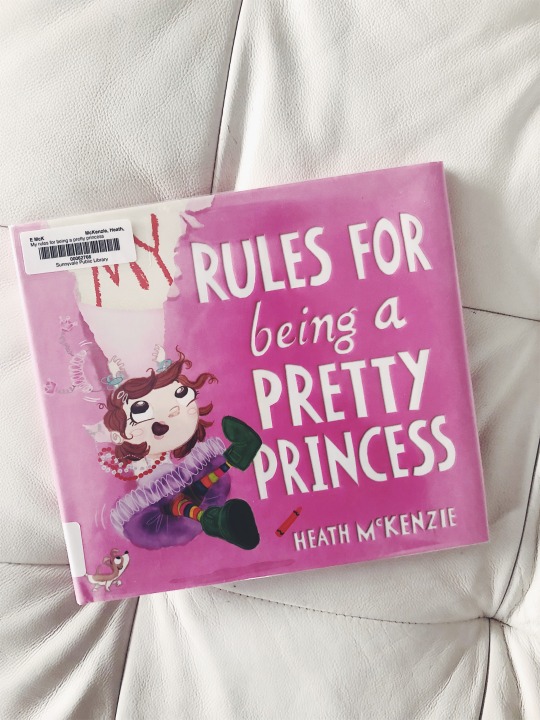
The protagonist in this book is an unnamed little girl who “more than anything else in the whole wide world,” wants to be a pretty princess. Her wish comes true when a real princess arrives and tells her the rules of being a princess: wear a pretty dress, always have perfect hair and makeup, attend dainty tea parties, dance gracefully, and finally, wait (literally, just stand there and wait) for a handsome prince.
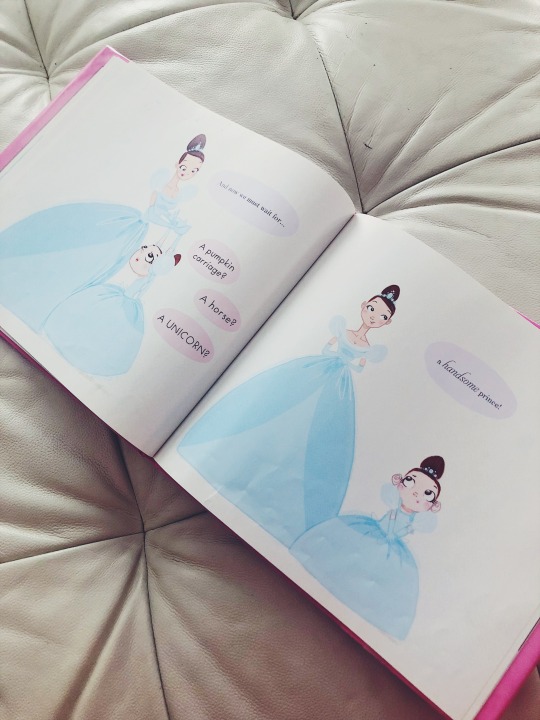

Our sweet little protagonist is quickly bored and uninterested in the rules of being a princess, so she makes her own. She decides that to be a princess, you simply have to be yourself. You wear FABULOUS (instead of uncomfortable) dresses. You have AMAZING (instead of “always perfect”) hair and makeup. You attend DELICIOUS instead of dainty parties. You simply dance, instead of always having to dance gracefully. And (my personal favorite part of the whole book) she scraps the rule about waiting on a prince entirely, and in a beautiful closing illustration, dresses up like a knight and becomes her own hero.

This book is a simple one only in the sense that it doesn’t have a lot of words. It’s more of a “comic-strip” style with pictures and speech bubbles. There isn’t a complicated plot or storyline, but despite being minimal in nature, this book is still radically “disturbing.” Even though I saw the name on the front cover, I didn’t think twice when I assumed a woman wrote the book for other young girls. When I finished the book and flipped to the blurb about the author on the back, I was surprised to see the photograph of male author Heath McKenzie, and even more pleased to read the explanation of why he created this book: “Before Ava [Heath’s daughter] was born and before he knew she’d be a little girl, Heath began wondering about what might happen if he had a daughter,” the blurb says. “He wanted to make sure she knew she could be anything she wanted to be when she grew up! Because she can!”
You could say that Heath wanted to “disturb the universe” on behalf of his little girl, and this book certainly does that. He wanted to tell his little girl something that ALL little girls (and honestly, all people) need to hear: “No matter what anyone says, YOU can be whatever you want.” And while there isn’t a complicated plot line in this story, the closing illustration subtly sends the message: “You don’t need saving and you don’t have to wait around for someone to come and get you—you can be your own hero.”
2) Dinosaur Expert written by Magaret McNamara and illustrated G. Brian Karas

This book is about Kimmy, a young girl who loves science, especially dinosaurs. She is excited to share all of her knowledge on a field trip to the dinosaur museum, but one of her classmates named Jake says, “Girls aren’t scientist.”

Kimmy sees all “boy names” in the list of accomplished paleontologists and gets discouraged. Maybe, she thinks, Jake is right—she shouldn’t talk anymore about dinosaurs because, after all, she is a girl. But when her teacher, Mr. Tiffin, shows her all the work done by female paleontologists, Kimmy realizes that Jake is all wrong: girls can be contributing scientists too.
While this book has a lot more words (there’s some big science words that even I struggled with), it teaches the same thing that Heath McKenzie wanted to show in his book: you can be anything. I love that they picked a “male dominated field” like paleontology to demonstrate this, but I think there’s also an extra layer in the use of dinosaurs. Dinosaurs are usually a “boy thing”—boys get to play with dino toys, boys get to watch Jurassic Park, and boys get to be paleontologists. But Mr. Tiffin helps Kimmy (and the readers of this book) realize that it isn’t a “boy-girl” thing: girls can love dinosaurs too. There’s also an extra “bonus” in the back of the book where Kimmy presents readers with seven different female paleontologists from all over the world and all different stages of life. (My personal favorite is Daisy Morris, a four-year-old who discovered the fossil of a new species of dinosaurs, which is now named “Vectidraco daisymorrisae” in her honor.)
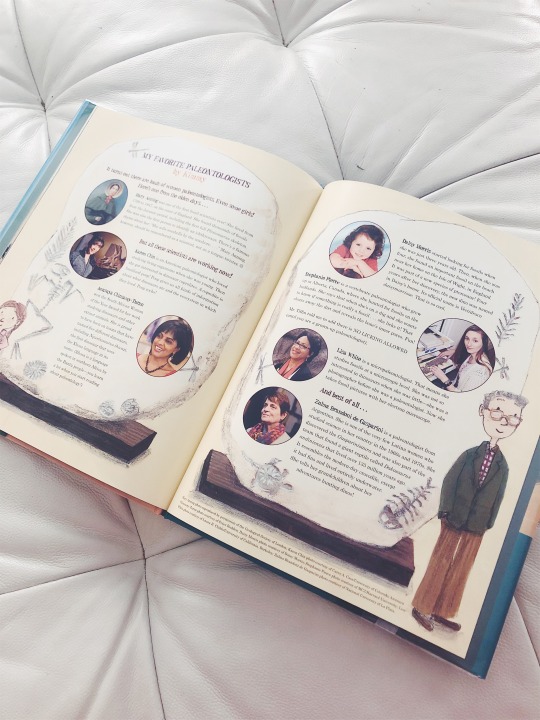
There’s so much educational information about dinosaurs in this book, even I learned a lot from it that I never knew. Personally, I think this book is one that is most powerful, because it’s not only educational, but also shows children that science and dinosaurs and being accomplished isn’t just for one gender: anyone can love and do and be whatever they want to.
3) I Dissent: Ruth Bader Ginsberg Makes Her Mark written by Bebbie Levy and illustrated by Elizabeth Baddeley
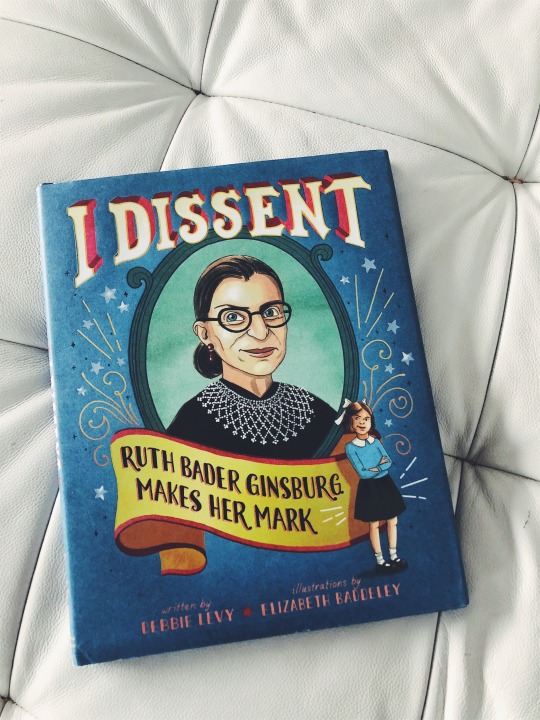
This book is obviously a nonfiction biographical book about Ruth Bader Ginsberg’s life from childhood to present day. It’s illustrations are amazing, and it shows beautifully how Justice Ginsberg encountered lots of difficulties—social things like racism and sexism, but also things like the death of her mother and raising a family while going to law school and pursuing a career.

While it focuses a lot on the aspect of female empowerment, it really is a book about standing up for right and injustice in general too.

Even though it’s probably the wordiest of all the books I mention here, that is not at all a bad thing. It has a lot of historical information and even teaches children vocabulary (specifically the terms “dissent,” “concur,” “object,” “protest”—lots of legal and activist terms), and adults can easily find a way to communicate the ideas to young children. I read this to one of my students (a six-year-old girl), and I had to find ways to “shorten and simplify” it a bit for her attention span and understanding. But when I asked her what she learned from the book, she looked up at me, smiled and said through the gap in her mouth where her front teeth should be, “Girls can do ANYTHING.” So I’d say she got the point.
4) The Princess and the Pony written and illustrated by Kate Beaton
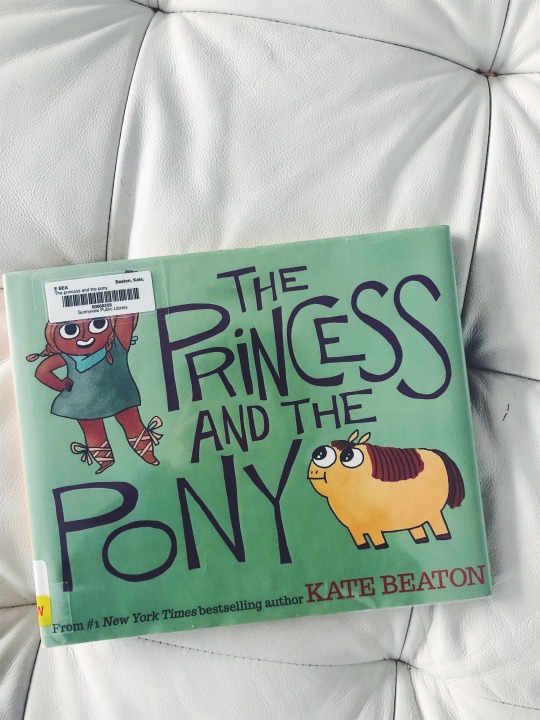
I go to the library literally every day for work, and a librarian approached me a few weeks ago and said, “Have you read The Princess and the Pony?” I am SO glad she suggested it, because it’s become one of my favorites.
The Princess and the Pony tells the story of Princess Pinecone, the smallest princess who wants desperately to be a big strong warrior. But Pinecone feels she is too “cute and cuddly.” “Warriors get fantastic birthday presents,” Beaton writes, “Things that make them feel like champions. Princess Pinecone got a lot of cozy sweaters. Warriors do not need cozy sweaters.” Pinecone tells EVERYONE she wants a strong warrior horse, but instead they give her a round little pony whose eyes sometimes look in two different directions, who eats things it shouldn’t, and farts way too much (not kidding, that’s in the book).


Pinecone tries hard to teach her pony to be a warrior horse, but the little horse just can’t quite get it; nevertheless, she enters a battle and hopes for the best. But instead of fighting and being “awful brutes,” the other warriors fall in love with Princess Pinecone’s cute little pony. They all stop fighting and gush over how cute the pony is. (My favorite is when Huge Harold, who also has eyes that sometimes look in two different directions, exclaims, “Aw, he looks a bit like me!”) When Pinecone says, “This is not how a battle usually goes!” another warrior responds, “You’re right, but we warriors don’t often get to show our cuddly sides.”


Pinecone realizes she can help them get in touch with their cute and cuddly sides, and all of the warriors work together and learn that being a strong warrior doesn’t mean you have to always be “very big and very tough.”
I love this book for a lot of reasons. First of all, this book is HILARIOUS. The illustrations are colorful and well-drawn and comical (especially the pony), and the details in the story itself are so funny. But I also love the subtle representation it offers. For example, Princess Pinecone’s parents are clearly drawn as an interracial couple: her mother has dark hair, skin, and eyes while her dad has light skin, blonde hair, and blue eyes. Pinecone herself is a mix of the two with dark eyes like her mother’s, blonde hair like her father’s, and skin that is a shade in between the two. The warriors themselves are all different shapes, sizes, and colors (in fact, in one illustration, there is a dark-skinned, female warrior in hijab subtly included in the fight). Even Harold’s little remark about how the pony “looks kinda like me” is representation—Harold sees a unique (not bad or funny, but unique) aspect of himself in a way perhaps he’s never seen himself before.
Another thing I love about this book is that unlike the princess in McKenzie’s book or Kimmy in Dinosaur Expert or even the great Ruth Bader Ginsberg herself encountered, there isn’t a clear outside force here: no one tells Pinecone she can’t be a warrior. Her parents support her completely, the warriors never question or make fun of her. The battle Pinecone struggles with is in herself. She thinks she is too small. She thinks she is too “cute and cuddly.” She thinks warriors don’t have the things she has, like cozy sweaters and fat ponies. She thinks these things make her weak. The struggle in Pinecone being a warrior is not one with the world outside of her: it’s an internal struggle with her own self-doubts.
Thankfully, Pinecone learns that warriors don’t have to be what she thinks. And, the other warriors learn this too. They all think that warriors have to be “a bunch of brutes,” as Beaton describes them. They (Pinecone included) think warriors have be tough and rough and always fight in some type of battle. But through Princess Pinecone’s silly little pony, warriors learn they can be cute and cuddly. Warriors can love cozy sweater and chubby ponies. Warriors can be small or big, male or female, and can appear rough or cute. And while I genuinely don’t believe there’s such thing as “girl and boy books” (all books are honestly for everyone), I do think another thing this book is especially good for disturbing the universe of toxic masculinity. It shows that to be strong, you don’t have to be a big tough brute who always fights angrily. It shows that it’s okay to be a warrior and be in touch with your “cuddly side.” It’s okay to wear a cozy sweater. It’s okay to gush over something that’s cute. It’s okay to feel. Through a story about a tiny princess and a farting pony, Beaton illustrates that being a warrior isn’t about your gender or your size or how many battles you partake in: it’s really just about being strong and accepting yourself just the way you are. And that’s a message that everyone needs to hear.
All of these books disturb the universe. These books make readers ask good questions. They cause readers to reevaluate their own ideas and the narrative around them. And they do it as children books. McKenzie’s sweet little princess helps us realize, “Hey, I don’t have to follow a set of rules and be perfect.” We learn along with Kimmy that girls can be scientists too (or whatever else they want). I Dissent shows that there is power in standing up to injustice and teaches toothless first graders ��Girls can do ANYTHING.” And The Princess and the Pony shows that there is strength in both the tough and the tender. As I said earlier, these aren’t books just for children. These are messages and themes we all need to hear. All of us, regardless of our age, race, or gender should read these books and allow them to disturb our universe.
#English major#children's literature#children's books#picture books#the princess and the pony#I dissent#dinosaur expert#my rules for being a pretty princess#female empowerment#feminist#feminism#literature#books#book
2 notes
·
View notes
Text
6/19/18
WRITER OF THE WEEK Octavia E. Butler was a visionary writer of science fiction. She drew inspiration from her local library and from the conviction that she could write better stories than the ones showcased by the then-popular B-movies.
SUMMER READING Now that school is winding to a close, don’t forget to keep your children reading over the summer break. We have prizes and raffles – featuring a variety of musical instruments – for children and teens who fill up their reading worksheets. Stop in for the details.
COLORING CIRCLE Join us for our monthly coloring circle for adults. Bring your supplies or use ours and enjoy a relaxing hour making art in good company this Thursday the 21st at 2 PM.
MOVIE NIGHT Also this Thursday at 5:30 PM we’ll be watching an animated movie about a hungry, mischievous bunny. We’ll provide the popcorn and drinks; you just bring yourself, your family, and your friends.
REGULAR PROGRAMS Music and Movement for toddlers is Tuesday at 10 AM. Stories and Songs, for ages 2 – 4, is Saturday at 10:30 AM. Call the library or check online for all of the details on all of our upcoming events.
JUST ARRIVED If your child enjoys visiting our library turtle Sophie Gertrude, check out the book Turtle Pond by James Gladstone to learn more about the life of red eared sliders in the wild. Dive in the ocean with The Brilliant Deep, about efforts to rebuild the world’s endangered coral reefs, or read the story of one woman’s work with a misunderstood animal in The Hyena Scientist. School-aged children might also enjoy Snails are Just My Speed, filled with gross-but-true facts about this common garden critter. You can help your child learn more about themselves and your family with the National Geographic Kids Guide to Genealogy, and teach them to appreciate other cultures through their celebrations in Every Month is a New Year. In fiction, children can read Bob by Wendy Mass, about an American girl visiting family in Australia and discovering that the monster in her old closet is quite friendly. Aisha Saeed’s Amal Unbound is about a girl sold into servitude who dreams of becoming a teacher, and Ojibway author Jan Bourdeau Waboose has created a beautifully-illustrated story with connections to legends of the fearsome Windigo. Finally this week, Akissi: Tales of Mischief is a collection of comic strips by Marguerite Abouet and Mathieu Sapin featuring the adventures and misadventures of a girl growing up in a West African village.
We welcome your QUESTIONS, COMMENTS, CONCERNS, PURCHASE REQUESTS, AND PROGRAMMING IDEAS. Contact us at 312 Washington Street, [email protected], 315-393-4325, or through any of our social media sites (you can do a search for Ogdensburg Public Library or find the links on our website, ogdlib.org.)
REGULAR HOURS are 9 AM to 8 PM on Monday, Tuesday, and Thursday, 9 AM to 5 PM on Wednesday and Friday, and 9 AM – 3 PM on Saturday. We look forward to hearing from you and seeing you at your library!
1 note
·
View note
Text
Comic Books as a Medium and Not a Genre
I remember being an avid reader of comic books when I was younger. The visual narrative of it appealed so much to me and I could not understand why all other books were not in the same format. They would be so much more interesting! Comics and graphic novels provided an engagement to me that ‘text-only’ books lacked. Versaci (2001), explained this notion saying that unlike 'traditional' literature, comic books can literally 'put a human face' on a subject. Comic books blend words and pictures so that, in addition to reading text, readers 'see' the characters through the illustration.
Crutcher (2011) in his article about the complexity of comics cited David Peterson- the creator of Mouse Guard- who put forward the idea that comics are unique to literature and film using texts, fonts, sound elements, images, and more, all to create a unique and sophisticated balance.
If this was how I felt about comics, I wonder why I reduced how much I read them. To be honest, there are many reasons but the most important was I developed the mindset that comics are more juvenile compared to traditional literature. I gravitated towards regular books in my late teenage years, but I continued reading Japanese comics which had a better reputation among adults and I could read them online.
With recent research, I realize I passed the same wrong judgment most people have about comic books by looking at them as a genre and not a medium. Versaci (2001) makes a case for this concept by asking to imagine meeting someone who disdained all film because he was no longer interested in Disney movies and associated all motion pictures with that one narrow genre. When most people hear the term “comics” they usually either think of childish superheroes or funny newspaper strips and dismiss any further potential it can have. The word ‘comics’ presents problems we're still figuring out because the term doesn't settle comfortably into our grammar; nomenclature remains tricky and open to debate (Chute, 2008)
“The use of the term ‘graphic novel’ in Britain and the US has, partly, been an attempt to rescue comics from their critical neglect, as well as to recognize the emergence of specifically adult comics and book-length works, particularly in the last 20 years”. (Frey and Noys 2002). Graphic novels as a term seem to have helped in giving the more grounded work that uses the visual narrative format a platform to be considered for scholarly appreciation and critical attention. A majority of researchers credit Art Spiegelman’s Maus (1986, 1991) as a milestone for the transformation of this medium. This representation of the Holocaust, through the memories of Spiegelman’s survivor father, demonstrated the potential of the form. Frey and Noys (2002), note that Maus has often been treated as a ‘one-off’ that can be safely treated with little debate.

https://www.colorado.edu/honorsjournal/2018/11/07/maus-art-spiegleman-graphic-novel-shows-power-memoir
Since Maus, there have been a couple of other critically acclaimed works like Joe Sacco’s Palestine, Marjane Satrapi’s Persepolis, Alison Bechdel’s Fun Home (Chute, 2008) to name a few. There has also been an increasing cross-cultural translation of the graphic novel, especially from cultures that do not regard it as an illegitimate form. For example, this is true for Japanese manga (comics) and animé (cartoon films) which have found new popularity over the last two decades globally (Freys and Noys, 2002).
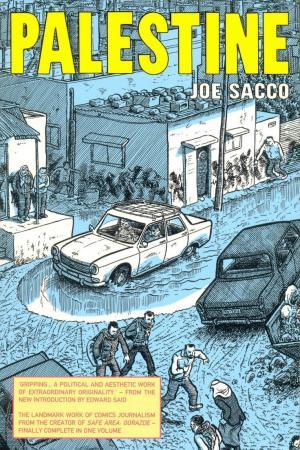
https://www.themantle.com/international-affairs/book-review-palestine-joe-sacco

https://www.graphicmedicine.org/comic-reviews/fun-home/
The medium has been undoubtedly been elevated; however, it seems like the legitimacy has been spared for only non-fiction work. Some superhero comic books have been adapted to films and have resulted in 5 of the highest-grossing movies globally. They most certainly should not be ignored or looked down on. Crutcher (2011) also has this train of thought and inquired about the definition and validation of the comics medium, not by focusing on historical or biographical work but through a selection of the Batman comics. He found the creators, artists, and writers of these comics provided a unique complexity not found in prose‐based novels or traditional films. “That complexity came through the (a) medium: the way writers, inkers, colorists, and others involved in the production of a graphic novel impose control, create layering, build atmosphere, and highlight artistic craft; (b) stories: how graphic novels work well beyond the superficial, delving into the human condition, political and cultural subversion, psychology, and the duality of persona; and (c) character: creating and sustaining icons that cross myriad temporal, visual, and setting ranges while paradoxically remaining coherent.”
I recently purchased a couple of X-Men comics (X-Men: Red, Volume 1 and 2 and Phoenix Resurrection: The Return of Jean Grey) and was pleasantly surprised and encouraged by the level of depth the stories carried, the art style, the sequential narrative, and the social commentary that the books encompassed. I did a critical analysis of X-Men: Red volumes earlier in this blog, and my thoughts are in more detail there.
Perhaps the reputational problem comics have had has been the meaning inherent in its name or the assumptions of what its audience should be, but holding on to those notions with so many quality works available and derivatives in other media limit the possibility of experiencing literature that could be life-changing or simply entertaining.
References
Chute, H. (2008). Comics as literature? reading graphic narrative. PMLA : Publications of the Modern Language Association of America, 123(2), 452-465. doi:10.1632/pmla.2008.123.2.452Link
Crutcher, P. A. (2011). Complexity in the comic and graphic novel medium: Inquiry through bestselling batman stories: Complexity in the comic and graphic novel medium. Journal of Popular Culture, 44(1), 53-72. doi:10.1111/j.1540-5931.2010.00819.x
Frey, H. & Noys, B. 2002, "Editorial: History in the graphic novel", Rethinking history, vol. 6, no. 3, pp. 255-260.
Versaci, R. (2001). How comic books can change the way our students see literature: One teacher's perspective. English Journal, 91(2), 61-67. doi:10.2307/822347Link
0 notes
Text
How ‘Curtis’ Tackled the Coronavirus in a Newspaper Comic
Curtis © 2020 King Features Syndicate Inc., World Rights Reserved/Photo Illustration by The Daily Beast
In the closing weeks of March, comics pages in daily newspapers were oblivious. People were still making plans. There were parties. When animals talked, as animals in comics do, they said nothing about quarantines.
One of the first voices to speak of the new normal belonged to Barry Taylor Wilkins, the younger of two brothers in Ray Billingsley’s long-running strip “Curtis.” It was on Monday, March 30, and we see Barry and Curtis’ mother, Diane Wilkins, squeezing hand sanitizer on her boys’ hands.
“Why do I have to put this stuff on my hands, Mommy?” asks Barry.
In “Curtis,” it is common for such questions to have both simple and complex answers. Since debuting the strip in 1988, Billingsley has mixed lighthearted gags with occasionally stark portrayals of the Wilkins, a middle-class African-American family, and their larger community of family, friends, barbers, and teachers. In “Curtis,” realism sneaks up on you: the family’s third-floor apartment can feel cramped; the father, Greg Wilkins, is uninspired by his job; and young brothers Barry and Curtis have real stresses, like fear of guns in school.
On this day, Curtis tells his brother the sanitizer is to clean his fingers before picking his nose. But we know the real reason. So does Diane. The boys don’t. But that will change.
Little Nemo Was the Most Beautiful Comic Strip Ever Drawn
At four panels a day, time moves slowly in a daily comic, even when events in other newspaper pages move alarmingly fast. As March finally gave way to April, the Wilkins family were seen adapting to their little corner of the pandemic. There are jokes about home-schooling and cabin fever. Greg tries to cheer his sons up with a theatrical display of pancake-making, flipping them with a juggler’s flare. “I try my best to shield my boys,” Greg will say to Diane. “And that is why I love you always,” thinks Diane.
Curtis © 2020 King Features Syndicate Inc., World Rights Reserved
Then, in the middle of breakfast, the Wilkins’ lives change again. Curtis receives a phone call. He walks back into the kitchen, dazed. His stack of pancakes is still waiting for him, untouched.
Story continues
“It’s our teacher, Mrs. Nelson,” Curtis says. “She tested positive for coronavirus.”
Curtis © 2020 King Features Syndicate Inc., World Rights Reserved
“I don’t want to start much trouble, but sometimes I can’t help myself,” Ray Billingsley told me in a recent phone interview from his home in Stanford, Connecticut, where he has been hunkered down with his basset hound, Biscuit. “It’s the artist in me.”
Ray Billingsley, the author of Curtis
Courtesy Ray Billingsley
Although a few new comics starring people of color have debuted in recent years, “Curtis” remains one of the few daily syndicated strips centered around black characters. Billingsley sees himself following in the tradition of Morrie Turner’s “Wee Pals” and Ted Shearer’s “Quincy”—and also Aaron McGruder’s “Boondocks,” but with a difference. “‘Boondocks’ was in your face, and he didn’t care how much,” Billingsley said. “The rest of us, we have to walk a tightrope.”
Billingsley tested that tightrope when the Wilkins family noticed that Barry was slipping milk out of the house. They thought he was feeding a cat but followed him and found instead an abandoned baby. In another strip, Diane miscarried after being assaulted at an ATM. “Nobody was expecting a miscarriage in ‘Curtis,’” Billingsley said.
One of the slyest moments in “Curtis” happened when the Wilkins family and friends were invited to Dagwood and Blondie Bumstead’s house, as part of a celebration of the 75th anniversary of the comic strip “Blondie.” They took a wrong turn and ended up in Mary Worth’s neighborhood. There, they discovered how fast police response time can be in a different part of town.
Billingsley often pushes against his six-week deadline to allow him the chance to comment on current events. Yet the experience of drawing “Curtis” during COVID-19 feels different than anything he has done before. “This one I’m going by instinct. I said, ‘It’s time to do it right now.’ I kept seeing that nobody was addressing this.”
Curtis © 2020 King Features Syndicate Inc., World Rights Reserved
I asked if he felt a special weight in his decision to have a character contract the illness. “Actually, I’ve been feeling the weight of this entire story,” he said. “I have to really get into what everyone was feeling. We’re talking about a core of four people and how it’s really affecting them as a unit. I’m not showing anyone else. It’s just about this family right now.”
“This has been one of the harder ones to draw. I had the flapjack party going on and I knew something was going to come up. When Curtis comes into the room, it hit me then, too. It made me depressed. I do it to myself. They’re so much from the heart that they can hurt me first. If I’m hit on an emotional level, I’m pretty sure other people will be too.”
People don’t usually die on the funny pages. It’s only possible in what’s called a “continuity” strip, one in which a narrative might stretch over many days or weeks. After all, Beetle Bailey can get beaten to a pulp and spring back up the next day, and nobody questions it. “In Beetle’s world, it doesn’t matter who’s president, or what kind of disease is going around,” laughed Billingsley, who counted the late “Beetle Bailey” creator Mort Walker among his friends.
The first major character to die in comics was Mary Gold, who in 1929 contracted a mysterious illness in the comic strip “The Gumps.” Since then, deaths have remained rare. In 2004, it came for the elderly Phyllis Blossom Wallet in “Gasoline Alley.” Garry Trudeau’s “Doonesbury” has featured several deaths, most controversially that of Andy Lippincott, who died of AIDS in 1990. Letters from readers poured in after the death of the family dog Farley in Lynn Johnston’s “For Better or For Worse.”
You didn’t see any death scenes in the comics page during the so-called Spanish Flu pandemic in 1918. Comics scholar Jared Gardner began searching through hundred-year-old newspapers for any comics that dealt with the outbreak and was surprised by how little he found. “Lots of words, lots of typing, but not lots of drawing,” Gardner said, speaking via Zoom from his home in Columbus, Ohio, where he serves as director of Popular Culture Studies at Ohio State University.
Public Domain
Gardner put what he did find on his website “Drawing Blood,” which is dedicated to comics and medicine. There is a single Bud Fisher “Mutt and Jeff” comic with the punchline “I went home last night and opened the window and in flew Enza.” A few comics discuss wearing masks and avoiding crowds. Some subscribe to the xenophobia suggested by the misnamed “Spanish flu.” Others lightly mock it, as in George Herriman’s “Krazy Kat,” in which Krazy dreams of a Spanish bullfight and wakes up the next morning with the flu, which “may or may not disprove the ‘germ’ theory,” as Herriman wryly notes.
Public Domain
Gardner suspects that the oversized cultural influence of comic strips in 1918 might be why there were so few mentions of the flu. Cartoonists and their bosses knew they were being watched. As John M. Barry wrote in his history The Great Influenza, the Sedition Act promised jail time for anyone who dared “print, write or publish any disloyal, profane, scurrilous, or abusive language about the government of the United States.” This even extended to “pessimistic stories,” and the trial of leftist cartoonist Art Young for violating the Espionage Act had proven that the government reach might extend to cartoonists.
It might have just been that most cartoonists didn’t think people wanted to see the flu in the funnies. Still, the few that did address it have a lesson to teach us. “It must have felt like the end of the world for these folks as surely as this time does for us,” Gardner said. “It can feel unprecedented and apocalyptic, but looking at comics from a hundred years ago reminds us that they got through it.”
The first widely syndicated newspaper comic to address COVID-19 was Bill Hinds’ “Tank McNamara,” a sports-themed strip that had to contend with the sudden absence of professional sports. “Curtis” followed shortly after. Cartoonist Stephan Pastis often makes himself a character in his smart and acerbic “Pearls Before Swine”; he drew his first coronavirus comics as if he were stranded with nothing but pencil and notepaper, playing off his real-life situation of being out of the country when the United States starting limiting travel. Meanwhile, a heartbreaking series in Darrin Bell’s “Candorville” tackled social isolation by showing full-panel cityscapes from throughout the world. The same thought arises in different languages from each house and apartment: “I am all alone.”
Argentinian cartoonist Ricardo Siri, whose comic “Macanudo” is published in English under his pen name “Liniers,” says the strip was born out of time of social and economic crisis in Argentina. “My way of being punk was to be optimistic,” he said, talking to me by phone from his current home in Vermont, where he teaches at Dartmouth College. His coronavirus-themed work has been delicate and hopeful, often turning to the natural world for inspiration. In one full-panel strip, a girl and cat sit together, watching a butterfly make its way across a grassy field. The caption reads: “Taking care of each other will also be contagious.”
“I feel like when people are drowning, you can either throw them a life vest or an anvil,” Siri said. “Every now and then I allow myself to be angry in the strip, or pessimistic, or nihilistic. But I think the reason the comics page first existed, from the Pulitzer and Hearst years, is to give people something so they don’t jump out the window.”
In a sense, the visual representation of COVID-19 is itself a cartoon—a multi-colored illustration of a spike protein-studded ball created by Alissa Eckert and Dan Higgins for the Centers for Disease Control and Prevention. (By contrast, Gardner notes that cartoonists in 1918 often used mosquitoes to represent the flu, due to the insects’ past association with sickness and death.) Eckert told The New York Times they were tasked with creating “an identity” for the coronavirus. But it took cartoonist Mark Tatulli to turn their image into a full-blown character. In Tatulli’s wincingly funny “Lio,” the Coronavirus might laugh menacingly or wait quietly in a doorway. In one chilling comic, it sits on the couch, watching the news. “It’s always weird seeing yourself on TV, ya know?” it says to a child.
To Gardner, these novel approaches to the novel coronavirus are a sign of hope for comics themselves. “If you want a media that can talk about it right now, and both comfort and educate, what does it better?” he said. “There’s social media, which is evil, and there are comics. It’s a moment where the comic strip, editorial cartooning, and web comics can talk about stuff as it’s happening, and they can build space for community in the moment—which is part of why comics and cartooning became so important in the first place.”
Added Gardner, “There’s a tone, a kind of intimacy, that the comic strip can capture that is really needed. I’m grateful for it.”
The most intimate moment in the current run of “Curtis” comes when Greg Wilkins is explaining to his son that because of social distancing, he can’t visit Mrs. Nelson in the hospital. Curtis pumps his fist and says, “Awwww, she’ll be all right!—Mrs. Nelson is a tough ol’ lady.”
Greg smiles and holds his son. He praises him for his positive attitude. What he doesn’t see—but what is clearly visible to readers—is that Curtis is crying.
I told Billingsley that this devotion of a student to a teacher reminded me of a series in Charles M. Schulz’s “Peanuts,” when Linus is watching his beloved teacher Miss Othmar during a teacher’s strike, and she falls down with exhaustion.
“Remember, only Linus was close to Miss Othmar,” says Billingsley. “Lucy wasn’t. It can be a very special bond between a student and a certain teacher.”
In fact, he said, Mrs. Nelson was the name of his own third-grade teacher. “I didn’t have the best home life, growing up. I had a father who was very strict. It got to the point where I looked forward to going to school, because I was away from my father. I was one of those weird kids who was good friends with the principal.
“Mrs. Nelson was the first person who told my parents I had a career in artwork. She encouraged me, and from that time on I kept drawing.
“So when Curtis put his head behind his father, I quietly cried to myself, because I knew I was going to do this.”
Since that moment, there have been jokes in “Curtis” about Curtis saying that he’s bored and being handed a mop and bucket, and of Greg admitting to his son that he misses “being at work complaining about being at work.” But Billingsley said he’ll be returning to the story about Mrs. Nelson. He doesn’t know exactly when. Just like when it started, he said, he’ll be going by instinct.
“When it’s time to wrap this story up, I’ll know it.”
Read more at The Daily Beast.
Get our top stories in your inbox every day. Sign up now!
Daily Beast Membership: Beast Inside goes deeper on the stories that matter to you. Learn more.
Source link
The post How ‘Curtis’ Tackled the Coronavirus in a Newspaper Comic appeared first on The Bleak Report.
from WordPress https://bleakreport.com/how-curtis-tackled-the-coronavirus-in-a-newspaper-comic/
0 notes